






See some of the amazing images from this year’s competition and find out how they were made
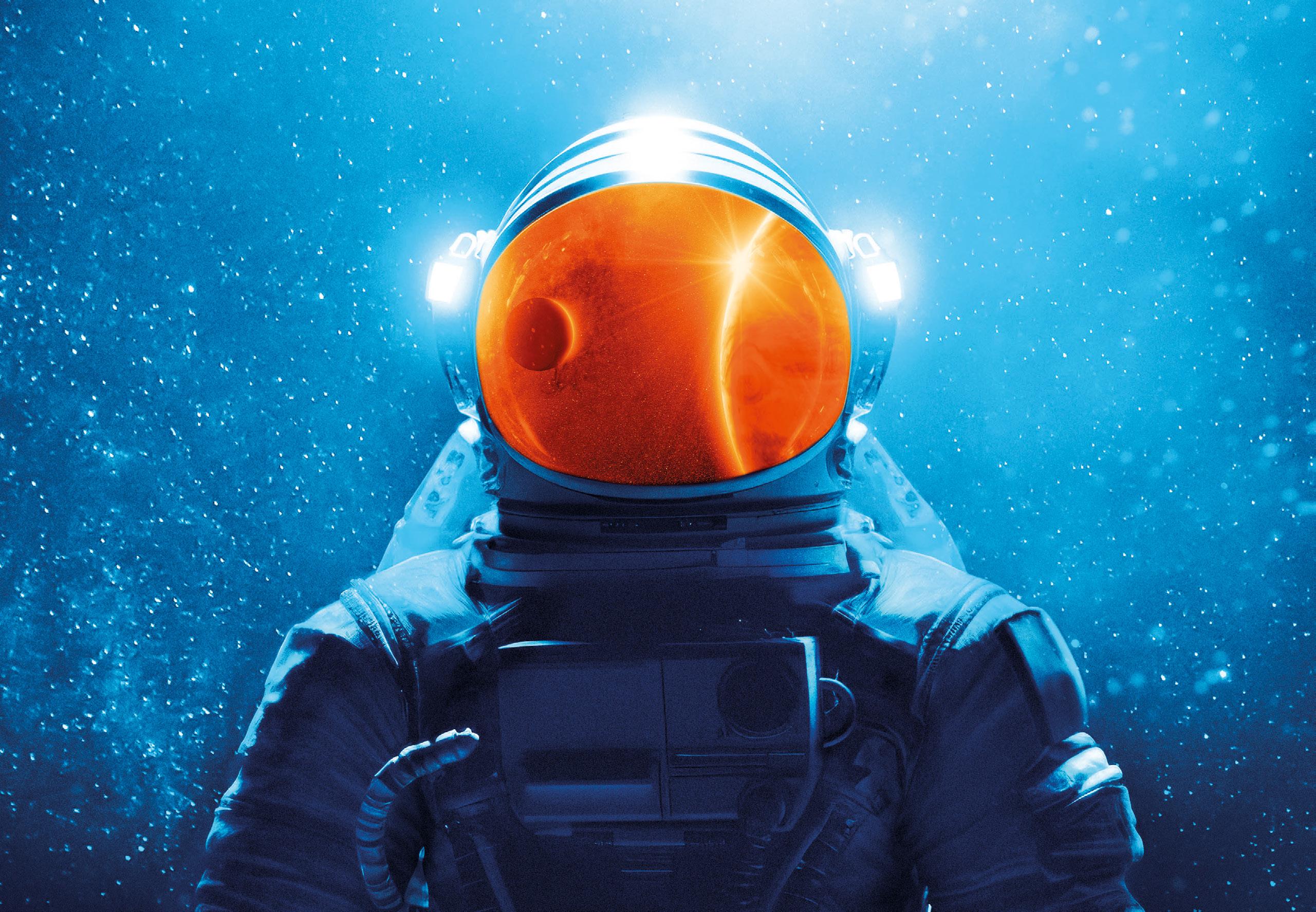





This month, we open the doors to one of our most anticipated events – the Wildlife Photographer of the Year exhibition. Now in its 61st year, the competition attracted over 60,000 entries from 113 countries, each frame capturing the beauty, fragility and resilience of the natural world. From this extraordinary collection, just 100 images were selected to tell the year’s most powerful stories. Enjoy some of our favourite images on page 24.
Today, the competition is more important than ever. It offers a powerful lens on the state of nature, revealing the far-reaching impact of human activity. The Museum’s research helps us understand this impact in greater depth and, this year, we’ve paired past winning images with new scientific insights from our Biodiversity Intactness Index – a vital scientific tool that reveals how wildlife is faring across the globe. Together, they illustrate not only what’s been lost, but what can still be protected for future generations.
The exhibition also showcases innovation in conservation. Last year’s winning photojournalism entry revealed a breakthrough technique: for the first time, fingerprints could be lifted from illegally traded ivory. To see this image and read more about this story, turn to page 38.
Our scientists continue to explore life in all its forms – past, present and possible. In June,
‘One of last year’s winners revealed a breakthrough: for the first time fingerprints could be lifted from illegally traded ivory’
we unveiled Enigmacursor mollyborthwickae, a newly discovered dog-sized dinosaur from the same rock formation as Sophie the Stegosaurus. This agile herbivore offers fresh clues about Jurassic ecosystems and now serves as the holotype for its species. Meet Enigmacursor on page 22. None of our work would be possible without your support. To our members, patrons, donors and friends – thank you. You help us protect the past, understand the present, and imagine the future.


Alex Burch, Director of Public Programmes
Instagram natural_history_museum
Facebook naturalhistorymuseum
X NHM_London
TikTok @its_nhm
YouTube @NaturalHistoryMuseum
The Natural History Museum, Cromwell Road, London SW7 5BD
The Natural History Museum at Tring, Akeman Street, Tring, Hertfordshire HP23 6AP
Email magazine@nhm.ac.uk

The Anning Rooms
Named in honour of legendary fossil hunter Mary Anning, this suite is exclusively for your enjoyment. Tuck into tasty lunches and snacks in the restaurant, take in the views from the lounge, or read a book in the study area.
Get free, unlimited entry to all of the Museum’s ticketed exhibitions, such as Space: Could Life Exist Beyond Earth? and Wildlife Photographer of the Year, and guaranteed entry to our free exhibitions and installations.
Enjoy private exhibition views, workshops and a talks series, Dig Deeper, led by Museum scientists. As well as discounted tickets you will also receive priority booking and access to a special Members’ Bar on the night.
Receive a 20% discount in the Museum’s shops –which are stocked with a wide range of inspiring gifts, books and clothes. You’ll also get a 10% discount in our cafés and restaurants.
Get Natural History Museum magazine delivered to your inbox. By receiving a digital copy instead of a paper one, you are helping to reduce the effects of production and printing on the environment. To switch to a digital magazine, please email membership@nhm.ac.uk
59 Autumn 2025



Professor Hugh Carter
Hugh is our Curator of Marine Invertebrates. His work focuses on understanding starfish distribution around the world.


Rebecca Keddie
As Assistant Archivist, Rebecca preserves, manages and provides access to the records that document the history of the Museum.

Professor Peter Grindrod
Peter is a Merit Researcher in Meteoritics and Planetary Science, studying planetary, lunar and asteroid surfaces –and is fascinated by the search for life on Mars.
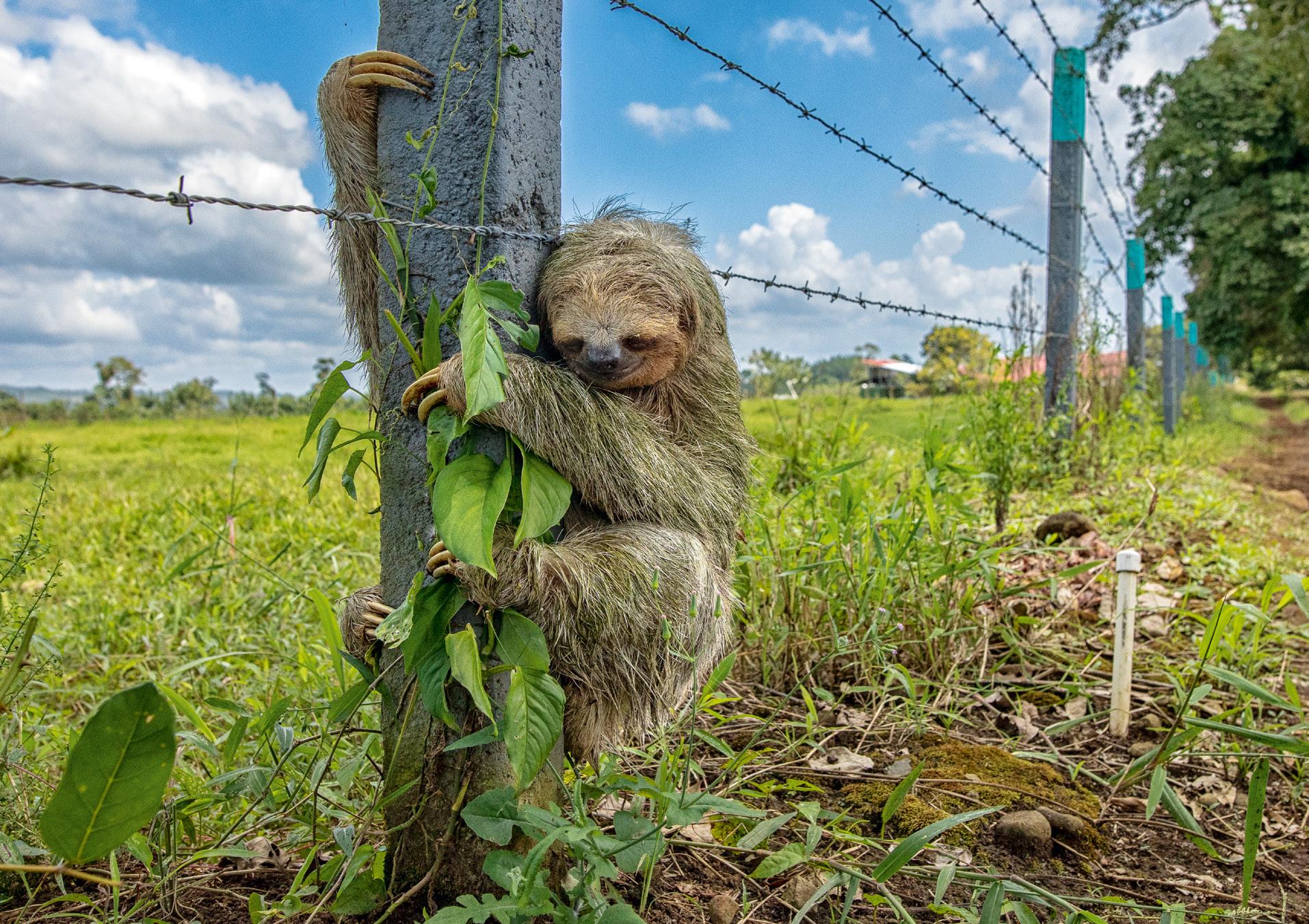


50

24 Wildlife Photographer of the Year
Feast your eyes on some of this year’s most awe-inspiring entries – from striking portraits and animal behaviour to the wonders of underwater and urban wildlife.
32 In safe hands
What can fossilised bones tell us about the differences between Neanderthal and Homo sapiens hands? Dr Emma Bird sheds light on this gripping evolutionary puzzle.
38 Silent witness
Discover how the Museum is teaming up with forensic specialists to pioneer techniques that combat the illegal wildlife trade – where science becomes a weapon against extinction.
44 Shape shifters
Step into the ancient seas with trilobites, the first arthropods in the fossil record, and see why these remarkable fossil invertebrates continue to fascinate and inform.
50 The real Jaws
To mark Jaws’ 50th anniversary, we separate shark fact from fiction – and dive into why these misunderstood ocean predators deserve a far better reputation than Hollywood ever gave them.
56 Standing up for the planet: Nathalie Cabrol
12
New at the Museum
In this issue, we explore how the Museum is sparking curiosity in the next generation, and helping to train young freshwater ecologists. Plus, we deep dive into The ‘Perfect’ Specimen, a podcast you won’t want to miss.
16 What’s on Events for Museum Members and Patrons, plus a 60-second chat with Zoom Through History.
18 Science in focus: Echoes under the ice
A recent expedition investigates how sea urchins in Antarctica are coping with ocean acidification, and reveals the long-term impact of climate change on marine life.
20 Inside story: James Armian As Manager of the Museum’s Contact Centre, no two days are the same for James.
22 Exceptional specimens: Enigmacursor mollyborthwickae
We unveil the new species of ‘mystery’ dinosaur now on display at the Museum.
Senior Editor Helen Sturge
Editorial team Josh Davis, Alessandro Giusti, Holly Murphy, Dr Peter Olson, Jennifer Pullar, Dr Helen Robertson, Professor Sara Russell and Dr Tom White
For Our Media
Editor Sophie Stafford
Art Editor Robin Coomber
Production Editor Rachael Stiles
Senior Account Director
Ella Wiggans
Creative Director Matthew Pink
Contributors James Armian, James Ashworth, Dr Alex Ball, Professor Paul Barrett, Dr Silvia Bello, Emma Bird, Paul Bloomfield, Georgie Britton, Dr Alex Burch, Nathalie Cabrol, Professor Hugh Carter, Kevin Coughlan, David Cowdrey, Nadia Devereux, Dr Greg Edgecombe, Professor Peter Grindrod, Rebecca Keddie, Professor Susannah Maidment, Lucy Minshall-Pearson, Mark Moseley, Bronwyn O’Reilly, Joshua Poole, Roberto Portela-Miguez, Lizzie Reay, Dr Arianna Salili-James, Karolyn Shindler, Dr Diego Vaz
With thanks to Heidi Brandenburg, Lorraine Cornish, Tim Ewin, Lucie Goodayle, Richie Howard, India Main, Rebecca McDonald, Wendy McGrath

Can life exist beyond Earth? Nathalie Cabrol, Director of the Carl Sagan Centre, shares bold insights on extraterrestrial life and nature’s resilience.
60 Revered and reviled
Great, difficult, visionary – meet Richard Owen, the pre-eminent anatomist whose complex legacy continues to intrigue and infuriate.
Every issue
6 Viewfinder
Be amazed by three extraordinary images that inspired everyone at the Museum.
66 From the Archive
Discover the unexpected tales behind the taxidermied dogs that became part of the Museums’ scientific legacy.
The views expressed in Natural History Museum magazine do not necessarily reflect those held by the Natural History Museum. Produced in association with Our Media. ourmedia.co.uk
All photographs and copy ©2025 The Trustees of the Natural History Museum, London unless otherwise stated. If you would like copies of any Museum images please contact the Museum Picture Library on 020 7942 5401.
ISSN 2044-7582
The paper used for this publication is responsibly sourced, and has enabled the capture of 57kg of CO2 at Thorney Coppice, Northamptonshire. Learn more at forestcarbon.co.uk
Natural History Museum magazine is mailed in packaging using potato starch along with other biological polymers. It is totally biodegradable and compostable and can be disposed of in the green recycling bin or a home compost bin. It can also be used in your food waste caddy.
Our Media Company is working to ensure that all of its paper comes from wellmanaged, FSC®-certified forests and other controlled sources. This magazine is printed on Forest Stewardship Council® (FSC®) certified paper. It can be recycled, for use in newspapers and packaging.


Brother Wolf – the image that changed everything
Jim Brandenburg, the legendary American environmentalist and wildlife photographer, captured one of the most iconic nature images of all time with Brother Wolf – a haunting portrait that won the Wildlife Photographer of the Year Competition in 1988 and helped redefine public perception of wolves.
Jim called it ‘one of the two most important pictures in my life’, the other being his famous image of a white wolf leaping across Arctic ice. The impact of Brother Wolf was profound: it inspired him to spend six months on Ellesmere Island documenting the private lives of Arctic wolves, resulting in his award-winning book White Wolf
He later turned his lens homeward, creating Brother Wolf, a best-selling tribute to the timber wolves of Minnesota. Through these works, Brandenburg gave voice to one of the world’s most misunderstood animals – and helped shift the narrative from fear to reverence.
Jim Brandenburg: 23 November 1945–4 April 2025





After more than 40 years at the Natural History Museum, Lorraine Cornish has retired as Head of Conservation, leaving a profound and lasting legacy. Beginning her career when specimen protection and preservation was still emerging as a field, Lorraine helped shape it into a cornerstone of Museum science.
‘Looking back over the past 45 years, it’s gratifying to see conservation become so essential to the Museum’s work,’ she reflects. ‘Women in science are now fully recognised, and conservators are valued specialists – something to celebrate.’
Lorraine led landmark projects, from relocating Hope the blue whale to preparing Dippy the Diplodocus for a national tour. Her expertise also shaped major exhibitions and safeguarded treasures like the Archaeopteryx, ensuring their stories continue to inspire for generations to come.
In 2028, the European Space Agency’s Rosalind Franklin rover will launch to Mars in search of the answer to one of science’s biggest questions: is there – or has there ever been –life beyond Earth?
The rover will land in Oxia Planum, a region rich in nearly four-billion-year-old rocks that contain evidence of prolonged periods of liquid water – conditions considered essential for life. Formed during a time when Mars was likely warmer, wetter and potentially habitable – just as life was beginning on Earth – these ancient rocks remain remarkably well preserved. Unlike Earth, where tectonic activity and erosion erase much of the early geological record, Mars offers a rare window into the planet’s distant past.
Scientists at the Natural History Museum are playing a key role in the mission – from helping select the landing site to designing and calibrating instruments. The rover’s PanCam and Enfys systems, mounted on its mast, were even fine-tuned using the Museum’s meteorite collection. Together, these tools will help the search for signs of ancient life preserved beneath the Martian surface.
VISIT THE MUSEUM
See this model of the Rosalind Franklin rover in the Museum’s Space: Could Life Exist Beyond Earth? exhibition until Sunday 22 February 2026.
Space: Could Life Exist Beyond Earth? is supported by Lead Funder Huo Family Foundation and Lead Corporate Sponsor Jupiter Asset Management.




For the past five years, the Museum has been putting cutting-edge science directly into the hands of students by lending portable scanning electron microscopes to schools across the UK, says Dr Alex Ball, Head of Imaging and Analysis Science Innovation Platforms.
In partnership with Hitachi High Technologies, Oxford Instruments and the Royal Microscopical Society (RMS), the Museum works with the Institute for Research in Schools (IRIS) to identify schools keen to take part. Each spring, schools submit research proposals to IRIS and a panel awards the loans of the microscopes based on proposal quality, student involvement and range of activities – with a focus on supporting schools in remote or disadvantaged areas.
Nearly 100 schools have taken part so far, with 30 hosting the microscopes and others engaging through visits or online. Over 250 teachers and technicians have been trained to operate the technology, boosting science literacy and professional development.
The impact is tangible and the feedback from students filled with uplifting anecdotes.
After using the microscope for a few weeks, one student decided that, rather than becoming a bricklayer, he wanted to train as an architect specialising in lowenergy building technology.
What would you view with a scanning electron microscope? Two portable SEMs are available to UK schools with bright ideas.
Another student is now mentored by a professor at Cambridge University after she won a national science competition. The programme’s curiosity-led approach has been especially powerful for students with special educational needs.

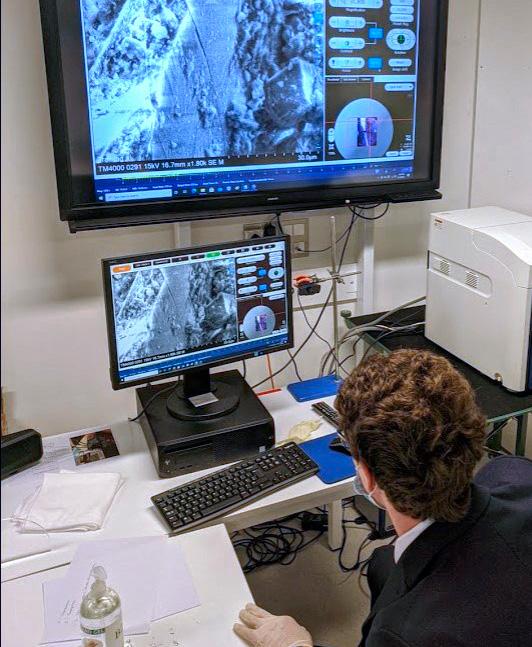
After using the microscope, one student decided he wanted to train as an architect, rather than as a bricklayer
Because students have extended access to the SEM, they’re encouraged to experiment, fail, and try again – developing resilience and hands-on skills early in their learning journeys.
Schools have also forged links with local businesses, creating work experience opportunities and building community connections. Many have partnered with local museums on public engagement events, giving students the chance to share their discoveries and build their confidence. With around 20,000 people reached so far, the programme is growing. Thanks to new funding, a second microscope has been secured – expanding the reach of this transformative initiative.
For more information about the programme, including how to apply, please visit researchinschools.org/campaign
40 million
Fossilised footprints uncovered in Australia could rewrite the timeline of life on land. The tracks belonging to early amniotes (ancestors of reptiles) push back the emergence of truly landdwelling vertebrates by as much as 40 million years.

100
A comparison of modern koala genomes with historical specimens from our collections reveals a sharp decline in their genetic diversity, raising their risk of extinction. Over the past century, koala numbers have plummeted due to hunting and habitat loss.

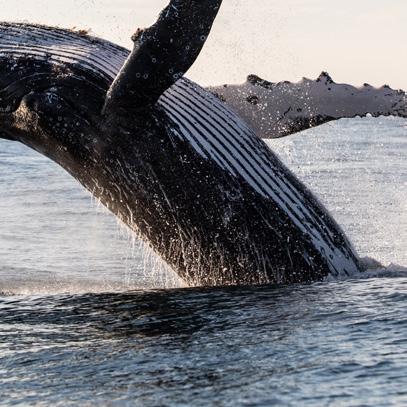
30%
An international team of scientists has tracked over 100 marine species and found that plans to protect nearly a third of the ocean may be insufficient to help large animals, such as whales, sharks, sea turtles and seabirds.
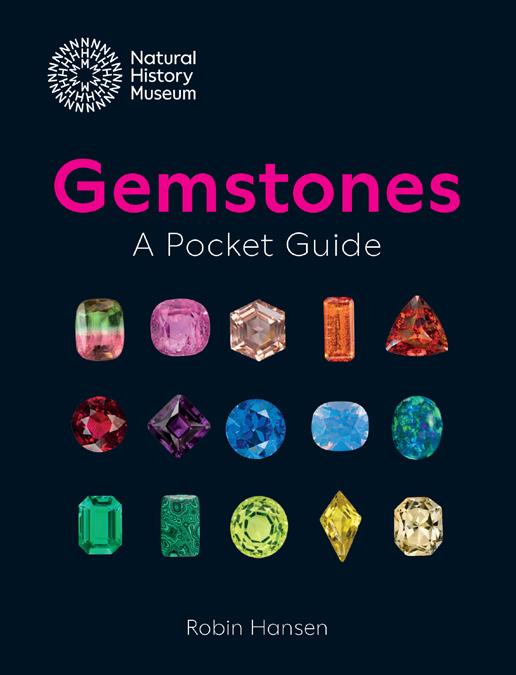
Gemstones have been a source of fascination for millennia – from the icy brilliance of diamonds and soft iridescence of pearls to the deep-red garnets treasured by ancient Egyptians and Victorians alike. They’re used for their natural beauty in jewellery, worn for protection as talismans, and associated with romance and power. They’re also of scientific importance, forming over billions of years and containing secrets of the inner Earth. This book examines the world’s most commonly encountered gemstones, exploring their unique beauty, rarity and durability. It reveals how they formed, where they’re mined, how they’re identified by their physical and optical properties, and their enhancements and imitations.
We have five copies of Gemstones: A Pocket Guide to give away. To be in with a chance of winning a copy, simply tell us the four Cs used to establish the quality of a diamond.
To enter the competition, send an email with your name, address, phone number and answer to magazine@nhm.ac.uk and put ‘Gemstones’ in the subject line. Or post your answer to ‘membership’ at the address on page 3. The closing date is Saturday 28 February 2026.
For more on upcoming training opportunities, visit nhm.ac.uk/ourscience/study/ training

Museum researchers are helping shape the future of freshwater science through hands-on training, reveals Dr Helen Robertson, Head of Postgraduate Programmes and Partnerships.
Training and supporting students and early-career researchers is integral to the Museum’s mission. This year, we secured funding from NERC (Natural Environment Research Council) to deliver three specialist courses for PhD students and professionals in biology, ecology and environmental science. The first, led in May by Dr Anne D Jungblut, focused on taxonomic identification and field techniques in monitoring freshwater ecology and water quality.
Fifteen keen young researchers from across the UK took part, gaining experience identifying aquatic invertebrates, algae, protists, lichens and macrophytes. Alongside lectures and lab work at the Museum, they ventured into the New Forest for sampling demonstrations and specimen collection.
Freshwater ecosystems are vital to biodiversity, clean water, agriculture and industry, yet face
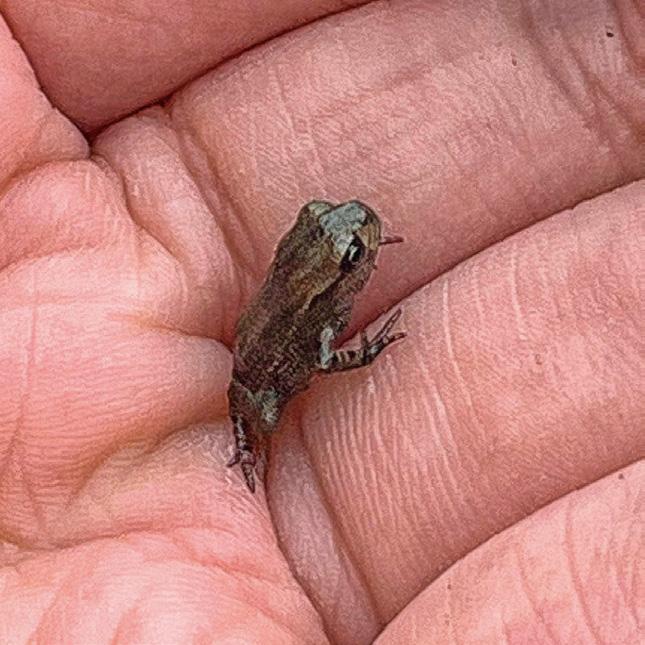

growing pressure from pollution, climate change and land use. Now in its seventh year, this course equips participants with skills to monitor and protect these fragile environments – whether they work in academia, conservation, consultancy or policy. ‘The NERC-funded course is a great opportunity to train the next generation of freshwater experts in a subject key to the Museum’s mission,’ says Anne. ‘It showcases our collections, shares our expertise and fosters collaboration, with participants building networks and confidence through shared fieldwork and discussion.’
Looking ahead, the Museum will run two more NERC-funded courses this year, continuing its commitment to scientific training and environmental research. For more information on upcoming training opportunities, visit nhm.ac.uk/our-science/study/training
Main Gathered at a lake’s edge, student researchers scan the water for aquatic life and signs of pollution.
Top This young frog is a vital indicator of water quality and ecosystem change.
Above Emergent vegetation helps researchers track ecological resilience in the face of climate change.

Explore choices that benefit both you and the planet. Whether it’s switching to LED bulbs, hosting a clothes swap or volunteering at a community garden, find inspiration at nhm.ac.uk/take-part/find-
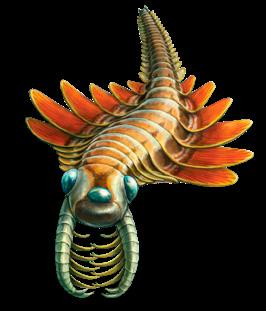
A new fossil has revealed surprising complexity in ancient arthropods. Named after the Godzilla monster, Mosura fentoni reveals surprising complexity in early arthropod anatomy, including a third eye.

The extensive archive of material produced by Charles Darwin has been recognised by the UN as a globally important cultural asset. The material, some of which is held in the Museum, provides an insight into his life and scientific work.
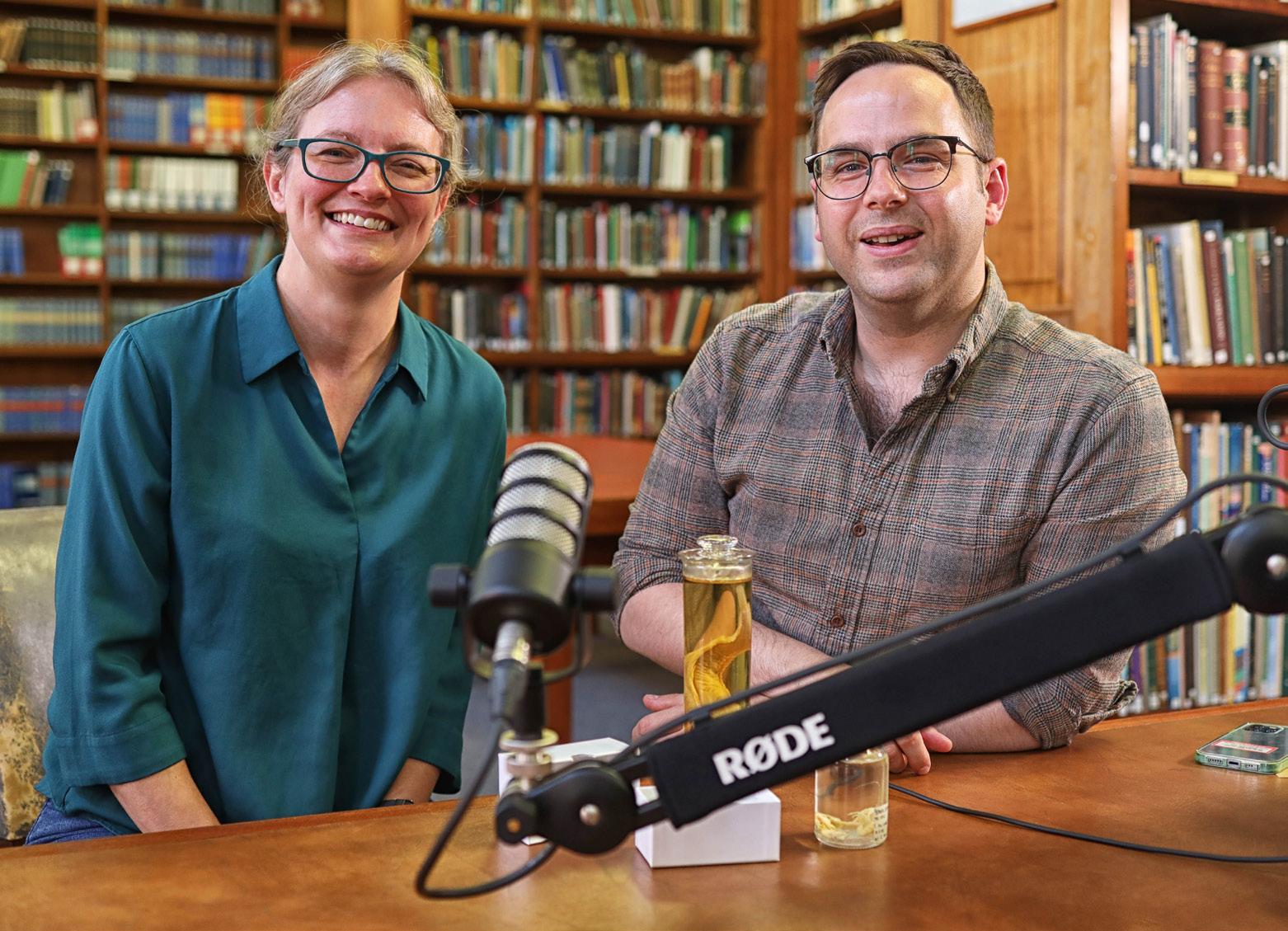
This summer, the Museum launched The ‘Perfect’ Specimen – a fresh, irreverent podcast that explores the surprising, unconventional and often brilliantly bizarre side of the natural world.
Hosted by zoologist Dr Natalie Cooper and author Josh Davis, the series opens the doors to some of the Museum’s lesserknown specimens and uncovers the quirky, fascinating stories behind them.
In each 30-minute episode, the duo dives into weird and wonderful corners of nature, using the Museum’s 80 million specimens as a springboard for curious, light-hearted conversations that mix knowledge with laughter. Their long-standing friendship and shared enthusiasm make them the ideal team to explore their chosen specimens and unexpected scientific connections.

We’ve joined forces with British artist Tim Bulmer to create a beautifully illustrated jigsaw puzzle that celebrates the Museum in all its splendour. Famed for his playful style and eye for detail, Tim brings a fresh perspective to this iconic institution – capturing the Museum’s
The ‘Perfect’ Specimen is available on all major podcast platforms and on YouTube at @NaturalHistoryMuseum
Each episode begins with a randomly assigned adjective – think ‘squishy’, ‘tacky’, or ‘exuberant’ – and the hosts must each present two specimens that embody the theme. From preserved objects and images to models and even cuddly toys, these selections spark a playful discussion and guessing game as each host tries to identify the link between the specimen and the adjective.
The result: a wide-ranging chat that blends scientific insight with cultural context, surprising facts, and some other personal favourites that didn’t make the cut.
Highlights include oddities like the ‘gummy squirrel sea cucumber’, the unforgettable ‘penis head fish’ and a waxy whale earplug – specimens that prove science can be as entertaining as it is enlightening, engaging and unexpectedly delightful.
grand architecture, rich history and remarkable exhibits. It’s the perfect challenge for puzzle lovers and a thoughtful gift for anyone with a passion for natural history.
Here’s your chance to win one of three signed copies. To enter, simply answer this question:
In what year did the Museum first open to the public?
Send your answer along with your name, address and phone number to magazine@nhm.ac.uk with ‘Puzzle’ in the subject line. Or post your entry to ‘Membership’ at the address on page 3. The closing date is 28 February 2026.

Space: Could Life Exist Beyond Earth?
Until Sunday 22 February 2026, Museum opening times
From £14 Adult / £7 Child / Concession £11.20 Members and Patrons go free Today there is more evidence than ever before to suggest there is life beyond Earth. Join us as we explore what we know so far. nhm.ac.uk/visit/exhibitions/ space
Wildlife Photographer of the Year
Until Sunday 12 July 2026, Museum opening times
From £15.50 Adult / £7.75 Child / £12.40 Concession Members and Patrons go free Enjoy more than 100 winning and commended images by leading photographers from around the world at the Museum’s annual exhibition of wildlife photography. nhm.ac.uk/wpy
Our Story with David Attenborough
Until Sunday 18 January 2026
From £20 Adult / £10 Child Members and Patrons from
£10 Adult / £5 Child
Immerse yourself in the epic tale of people and planet in this new 360˚ experience and listen to Sir David as he reflects on his lifetime exploring our planet. nhm.ac.uk/visit/exhibitions/ our-story-with-davidattenborough
Dino Snores for Kids
Every month, 18.45–10.00
£85 non-members / £76.50 members
Ever wonder what happens in the Museum when everyone’s gone home?
During this action-packed sleepover, you’ll take part in fun, educational activities, discover our T. rex in the shadows of the Dinosaurs gallery, follow a torch-lit trail, and experience a live science show with a Museum scientist. In the morning there’s breakfast and a trail of the galleries. For ages 7-11. nhm.ac.uk/dino-snores
Dino Snores for Grown-ups
Various dates, 18.30–9.30
£220 non-members / £198 members
Pull an all-nighter at
the Museum for an unforgettable evening of comedy, food, science and cinema. Enjoy live shows, a delicious three-course dinner, live music, including a harpist, and Museum pub quizzes, followed by a hot breakfast the next morning. For ages 18 and over. nhm.ac.uk/dsgu
Visions of Nature: A mixed reality experience
Open daily, 10.15–16.45
£9.95 non-members / £7.95 members
Be transported a century into the future to explore what could lie ahead for the planet. Journey around the globe and become visually and audibly surrounded by the awe and wonder of the future natural world. nhm.ac.uk/visit/exhibitions/ visions-of-nature
Behind the Scenes Tour: Spirit Collection
Various dates, 15.00–15.45
£25 non-members / £22 members
Go behind the scenes in the Museum’s Darwin Centre for a look at our fascinating zoology collection preserved in spirit. Explore some of the numerous treasures hidden among the 22 million animal specimens housed there. nhm.ac.uk/events/behindthe-scenes-tour-the-spiritcollection
Museum Highlights Tour
Various dates and times
£15 non-members / £12 members
From the awe-inspiring blue whale skeleton suspended from our ceiling to the largest blue topaz gemstone of its kind, the specimens we care for are
Find out what’s on at the Museum, and plan your next great day out, by visiting nhm.ac.uk/whats-on
full of wonder. Join one of our knowledgeable guides to explore our very best highlights.
nhm.ac.uk/events/ museum-highlights-tour
Gender and Sexual Diversity Tour
First Wednesday and first Saturday of the month, 12.15–13.00 and 13.15–14.00
This free tour takes you through several of our galleries, highlighting the diversity of gender and sex in the natural world. Learn about the variety of gendered roles in nature and explore the sexualities of different species. nhm.ac.uk/events/diversehistory-of-science-tours
Members Family Morning: Space
Saturday 8 November, 8.00–10.00
A morning of fun-filled activities, workshops and crafts themed around our new exhibition, Space: Could Life Exist Beyond Earth? With access to our galleries and exhibitions, see fascinating specimens that will inspire both big and little minds.
Members Workshop Saturday 29 November, 11.00–11.45, 12.15–13.00, 14.00–14.45, 15.15–16.00
Bring the children along for a fun, interactive session to learn all about some of natural history’s legends, from pioneering fossil hunter
Please note: Some dates and times are subject to change. For further information on members events, visit nhm.ac.uk/membership
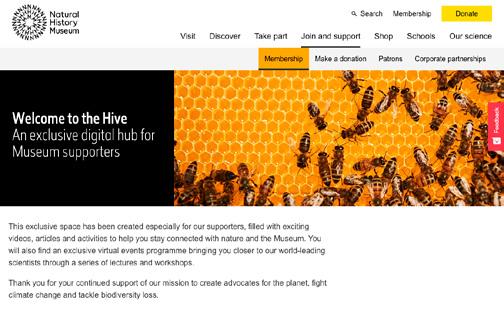
An exclusive digital hub especially for our supporters, the Hive is filled with exciting videos, articles and activities to help you stay connected with nature and the Museum. Here you’ll also find an exclusive virtual events programme, bringing you closer to our world-leading scientists through a series of lectures and workshops. Discover it all at nhm.ac.uk/the-hive


By Lizzie Reay

and palaeontologist
Mary Anning to history’s most famous biologist, Charles Darwin.
Dig Deeper: Discovering a New Species
Wednesday 21 January, 18.30–20.30
Delve into our pioneering projects and find out more about our collections as we celebrate and showcase the world-leading scientific research we carry out here at the Museum.
In addition to Members events, Patrons enjoy a specifically curated programme.
Behind the Scenes Tour –
The Vault
Wednesday 12 November, 18.30–20.30
Open to Gold Patrons,
Platinum Patrons and Family Platinum Patrons
Join us on an exploration of the collections within The Vault and see some of nature’s most unique and valuable treasures not on display – from coloured diamonds to rare meteorites from out of this world.
Patrons Tour and Christmas
Drinks – Natural History Museum at Tring
Monday 1 December, evening event
Open to all Patrons
Join us for this special, private tour of our beautiful Museum in Tring while it is closed to the public for the day then raise a glass to the festive season!
Please note: Some dates and times are subject to change. If you have any questions about upcoming events, please contact patrons@nhm.ac.uk
Tell us about Zoom Through History
We are the historical events and education branch of Ceridwen Theatre Company. We provide museums, heritage sites, schools and businesses with historical characters for events, workshops, plays, digital content and more! We take history off the pages in a fun, accessible way.
How do create characters and content for the tours? A lot of research goes into every event and workshop. We begin with a site visit, before exploring sources on the historical figure we are portraying. Costumes are also essential in bringing their world to life.
Why is interactive storytelling a powerful tool for learning?
When learning becomes an adventure, it’s no longer just words on a page; it’s excitement, discovery and wonder. Historical figures step out of textbooks to share their theories, inviting questions you’ve always wanted answered. It’s a chance for people to experience science and history in a unique way.
What’s special about performing at the Museum?
It is such an incredible place, spanning billions of years of Earth’s history, celebrating amazing historical scientists – and the new gardens are wonderful. It’s a privilege to perform here and to bring its history to life.
Do you have a favourite theme or character you’ve brought to the Museum?
Nadia: It has to be Mary Anning. She is such an incredible figure to research, write about and portray. It’s been wonderful witnessing the growth in awareness of her story and recognition of her achievements and the hardships she faced.
Josh: I particularly love playing our fictional character, Joe Rassic –part of the comedy explorer duo who guide young adventurers around the Museum spaces.
WATCH THIS
See Zoom Through History at our Family Morning in November (details left) or find out more at zoomthroughhistory.com

The lowdown
What?
On 14 January 2025, the research vessel Tangaroa began its 16th Antarctic voyage to the Southern Ocean.
Where?
Leaving Wellington, New Zealand, the ship visited the remote and ecologically vital western Ross Sea region of Antarctica.
When?
The journey lasted 39 days, including 30 within the protected Antarctic Treaty area.
Why?
Global scientists collaborated to study climate-linked ocean processes and assess the health of the Ross Sea ecosystem.
Over a century after Scott’s expedition, the Museum visited Antarctica with cutting-edge technology. Science Communications Manager Jen Pullar reveals what the team uncovered.
More than a century after Robert Falcon Scott and Ernest Shackleton ventured into Antarctica during the Heroic Age of Exploration, Museum scientists are retracing their footsteps – this time to unlock the secrets of biodiversity in a rapidly changing world.
Scott’s expeditions aboard the Discovery (1901–1904) and Terra Nova (1910–1913) helped lay the foundations for Antarctic science. Now, one
of the Museum’s curators of marine invertebrates, Professor Hugh Carter (pictured), has joined an international team on the TAN2502 ACTUATE voyage aboard the research vessel Tangaroa. Their mission: to explore the Ross Sea to investigate how climate change and human activity are affecting this frozen frontier.
Thanks to favourable sea ice conditions, the team was able to access rarely studied areas that are normally closed
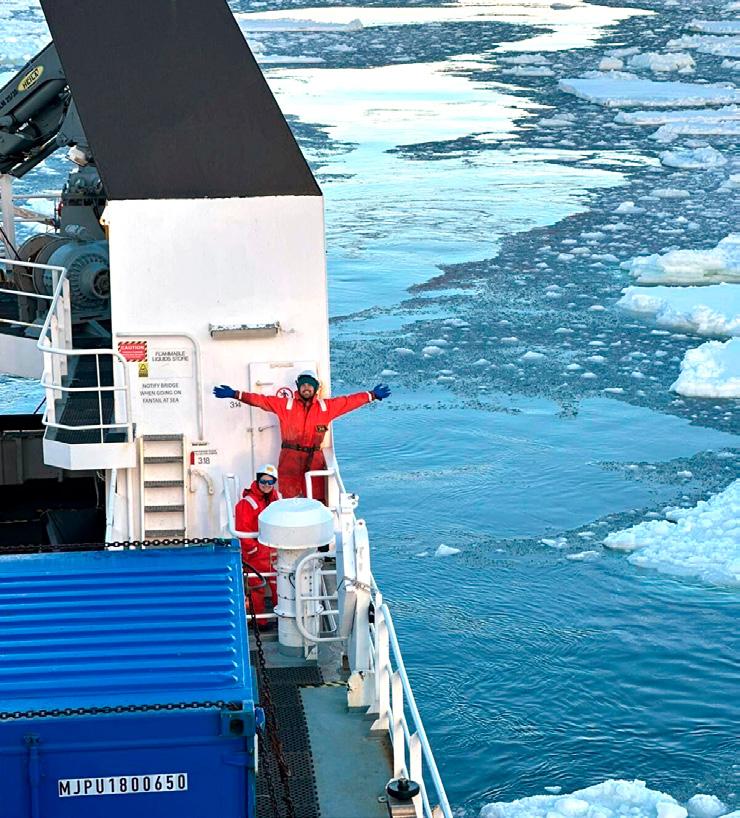
fact
Working on this voyage gave Hugh one of the shortest commutes imaginable: a quick climb from his bunk, up a single flight of stairs, and he was in the office – ready to begin a day of Antarctic science.
off to scientific research. These included a deep channel west of Coulman Island – likely never sampled from a ship – and Cape Wadworth, where Scott once placed a message pole.
Remarkably, they collected samples just metres from where the Discovery did 125 years ago.
While traditional techniques like deep-sea trawling – used in Scott’s time – are still employed today, this recent expedition was steered by advanced technology and strict environmental guidelines that were unheard of a century ago. ‘We had a fantastic camera rig that tracked the sea floor before sampling,’ says Hugh. ‘It helped us choose sites carefully and gave us a visual record of the untouched ocean floor.’
These images offer a rare and valuable glimpse of biodiverse sea floor ecosystems that are free from fishing and other human intervention and impacts such as plastic pollution. Since 1982, Antarctica has been designated a Marine Protected Area by the Commission for the Conservation of Antarctic Marine Living Resources, making it one of the few places on Earth where fishing is tightly restricted or, in some places, banned altogether.
‘Our camera rig gave us a visual record of the untouched ocean floor’
The data collected is already revealing some intriguing clues. Scientists noticed possible changes in species compared to specimens gathered from the same location over a century ago – raising questions about how even this remote region may be shifting under global pressures.
By combining historical context with cutting-edge science, the ACTUATE voyage is helping researchers understand what a pristine ocean might look like – and what we stand to lose. Antarctica remains a place of wonder, but also a vital barometer for the health of our planet. ●
As ocean acidity rises, scientists are investigating how sea urchins in Antarctica are coping. By comparing modern specimens with century-old samples from the Museum’s collection, they’re uncovering signs of fragility in these creatures that could reveal the long-term impact of climate change on marine life.


Understanding the challenge
As levels of carbon dioxide (CO₂) in the atmosphere have risen, much of it has been absorbed by the Ross Sea. This makes seawater more acidic, which directly affects echinoderms. Sea urchins build their shells and skeletons using calcium carbonate – a substance that dissolves more easily in acidic conditions. As a result, they may struggle to form thick, durable shells.

1 3
Scanning historic specimens
Back at the Museum, scientists are using CT scanners to image historic urchins from the collection. These highresolution scans produce 3D models that allow precise measurements to be taken of key anatomical structures in the urchins’ bodies, including their test wall (shell) and what’s known as Aristotle’s lantern (feeding apparatus).
Collecting modern specimens
To investigate whether sea urchin shells have become more brittle over time, researchers aboard the TAN2502 ACTUATE voyage collected fresh samples from the seabed to compare with historic specimens held in the Museum’s collection. To do this, these delicate specimens were transported with great care across the globe, highlighting their noticeable fragility.

2 4
Comparing old and new
Researchers are now comparing the modern samples with those collected over a century ago by Scott and Shackleton. While multiple environmental and biological factors may be involved, early results suggest today’s urchins are significantly more fragile, raising serious concerns about their long-term survival in an increasingly acidic ocean.
As Contact Centre Manager, James Armian expertly handles the Museum’s daily stream of enquiries, from lost property to visitor questions.
My life in a nutshell
I grew up loving news programmes and dreamed of being a newsreader, breaking stories every night.
After completing an English degree, I worked in hospital communications before moving into tourism.
My training in journalism helps me write useful, concise communications for visitors.
Outside work I build and collect Lego –including a Lego T. rex skull in my office.
I host a Eurovision party every year, with scorecards. I hope to attend the live show one day!
What do you do at the Museum?
I lead the team that looks after all the enquiries received from the Museum’s members, customers and visitors. We field about 1,000 emails a week and around 80 calls a day, and this can easily double during the summer.
teams across the Museum is key. We aim to respond quickly and helpfully, and set internal targets to make sure we deliver the best possible service.
Which Museum exhibitions have attracted the most queries?
We’ve had lots of enquiries about the new one Our Story with David Attenborough, which opened this summer. Sir David is a huge draw, and as the Museum’s first immersive experience of this kind, visitors know it’s going to be top quality and inspirational. Wildlife Photographer of the Year continues to be a firm favourite, generating interest year-round. Our current exhibition Space: Could Life Exist Beyond Earth? is also popular – appealing to a slightly different audience and showcasing the breadth of the Museum’s research in new and exciting ways.
What’s one of the most memorable queries you and the team have received?
We receive calls from all over the world – not just the UK. I once spoke with someone in Australia who was planning a visit; I’m not sure what time of the night it was for them! Visitors from across Europe and the US often reach out to us, too.
Got a question for the Museum? Email the team at feedback@nhm. ac.uk
I often describe my role as looking after the people who look after our visitors. I make sure my team has the tools, support and confidence they need to help as many people as possible. A key part of my work also involves representing the voice of the customer in meetings across the Museum – ensuring that any decisions consider the experience and needs of our visitors. Leading a frontline team means keeping the ‘bigger picture’ in focus at all times, so we can create a welcoming, seamless experience from the very first point of contact.
What type of queries do you manage on a day-to-day basis?
Some people think the Contact Centre is like a switchboard – but it’s so much more. My team and I support visitors, members and enquirers with everything from booking changes and school visits to lost property and queries about the online shop. We also handle the unexpected, so staying up to date with information and connected with other
Some of the most memorable calls come from parents whose children are inspired by nature and they’re looking for ways to nurture that interest. One particularly moving enquiry came from someone with a terminal illness who wanted to make special memories with their son – we arranged a VIP visit for the family with some thoughtful extras to make the day truly unforgettable.
Of course, not every call is quite so serious – we occasionally get prank requests for ‘Mrs Diana Saur’ or ‘Terry Dactyl’. And plenty of people call asking about the mummies (they’re at the British Museum) or the Wonderlab (that’s the Science Museum)!
What inspires you about the Museum?
The Museum’s mission of creating advocates for the planet has inspired me since I started this job. Growing up, my family encouraged me to take an interest in, and be aware of, the natural world and I love the fact that this Museum, which is all about nature, is one of the UK’s leading visitor attractions. It’s wonderful to know we’re helping to make those visits happen and, in doing so, inspiring others to make positive changes for the planet. I also love the variety my role brings – every day is different! ●

Meet the Museum’s newest dinosaur – a vivid clue to the overlooked diversity that once scurried beneath the feet of Jurassic giants.
Scientific name
Enigmacursor mollyborthwickae
Chosen by Professor Paul Barrett Science Background
Palaeontologist and co-lead author of the research
Named Enigmacursor mollyborthwickae a newly described small dinosaur is the most complete named specimen of its kind. This fleet-footed herbivore is also a key to unlocking the hidden diversity of the Late Jurassic.
With long, graceful legs and an elongated tail, Enigmacursor was built for running. But rather than using speed to chase prey, it likely used its agility to avoid becoming lunch itself.
Around 150 million years ago, when Enigmacursor roamed the Earth, the world looked very different. The North Atlantic Ocean had just formed, and the supercontinents of Laurasia and Gondwana were breaking apart. North America was a patchwork of snaking river systems, huge conifer forests and sweeping fern prairies.
These landscapes were ruled by giants –thundering sauropods like fearsome predators such as the biggest dinosaurs drew the most attention, both in life and in death, beneath their shadows
After reviewing all the fossils attributed to Nanosaurus, we reached a surprising conclusion: the species didn’t really exist
The lowdown
Jurassic neighbourhood
Enigmacursor roamed what is now North America during the Late Jurassic, between 152 and 145 million years ago, sharing its world with better-known giants such as Diplodocus and Allosaurus.
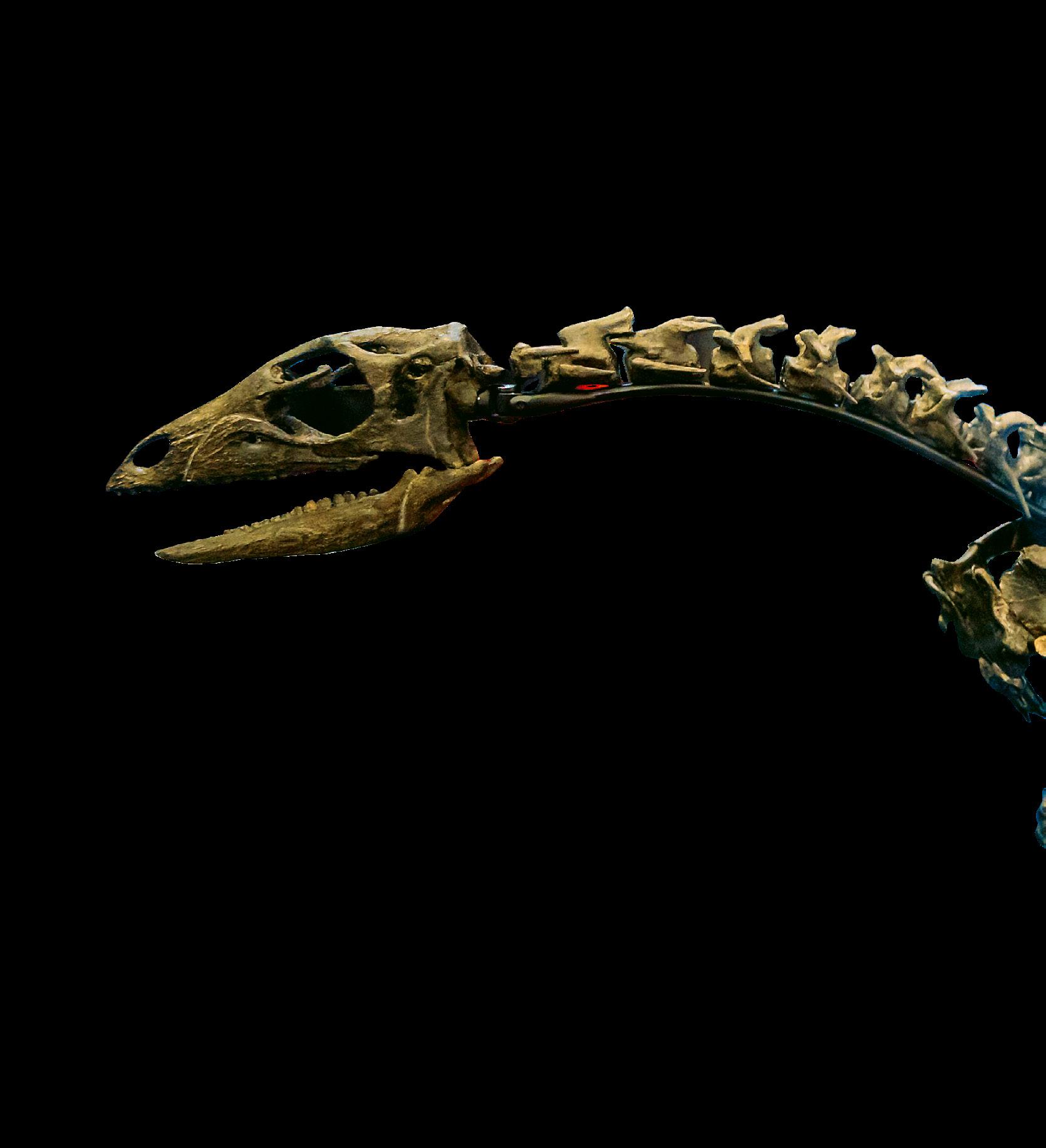
acquisition and display at the Museum possible. With Enigmacursor added to the roll-call of Late Jurassic fauna in North America, we hope it will shine a light on the overlooked smaller species of the era. There are likely many more still waiting to be named. ●
Dog-sized dino
The Morrison Formation in the US has yielded some of the world’s most iconic dinosaurs – but not all were towering leviathans. At 64cm tall and 180cm long, Enigmacursor was about the size of a labrador.
Legs for days
With long, slender hindlimbs and large feet, Enigmacursor was built for speed – perfect for dashing through Jurassic undergrowth and dodging predators. Its name means ‘puzzling runner’.
Tail of balance
Enigmacursor’s long, thin tail wasn’t just for show – it acted as a crucial counterbalance, helping this little runner stay upright during highspeed turns through dense Jurassic forests.
With its long legs, lightweight frame and distinctive limb bones, Enigmacursor has a runner’s build – adapted for speed and agility in Jurassic floodplains.

Though the skull is missing, Enigmacursor’s small, rounded teeth reveal a plant-based diet. It probably ate ferns, cycads and horsetails, which were dominant plants 150 million years ago.
Enigmacursor is the first new dinosaur to go on display at the Museum since Sophie the Stegosaurus was unveiled in the Earth Hall in 2014.
This dinosaur was still growing when it died – some spinal bones are not yet fused, suggesting it may have been a juvenile. It’s unclear how it died, as there are no obvious signs of injury or illness.
Enigmacursor was discovered in the same rock formation as Dippy the Diplodocus, meaning these two very different dinosaurs once shared the same dynamic and diverse Late Jurassic landscape.
The closest known relative of Enigmacursor is Yandusaurus, a small, plant-eating biped from China that lived during the Middle Jurassic, around 169–159 million years ago.

Animals in their Environment, Highly Commended Bertie Gregory, UK
Bertie spent two months with the penguin colony and witnessed most chicks using ice ramps to descend to sea level for food. But this group missed the easy way down. Keeping his drone at a safe distance, he watched as they took a 15-metre (49-foot) leap into the water. Left to fend for themselves, emperor penguin chicks must find a way to make their first dip into the icy ocean to find food. Scientists believe the continued decline of sea ice in Antarctica may force more penguins to breed on ice shelves, making this behaviour increasingly common in the future.
Location: Ekström Ice Shelf, Atka Bay, Antarctica
Technical details: DJI Mavic 3
Pro + Hasselblad L2D-20c 24mm f2.8 lens; 1/50 at f3.5; ISO 100

The prestigious competition attracts the best nature and wildlife images from around the world. Here are a few of our favourites from the 2025 winners.

Behaviour: Invertebrates, Highly Commended Bidyut Kalita, India
Bidyut spotted this potter wasp building a mud chamber on a picture frame in his home in Goalpara, northeast India. Noticing it coming and going several times a day, he wedged the door open to allow it access until he finally saw it returning with prey gripped in its jaws.
Once the chamber is complete, the wasp sets about packing it with caterpillars paralysed by a sting, to provide live food for the developing larvae within.
Location: Goalpara, Assam, India
Technical details: Canon EOS
R6 + 85mm f2 macro lens; 1/125 at f10; ISO 500; Canon Speedlite 470EX-AI flash + Beetle macro diffuser
Animal Portraits, Highly Commended Amit Eshel, Israel
In temperatures of -35°C (-31°F), Amit struggled to fulfil his dream of photographing the elusive Arctic wolves of Ellesmere Island. But then, on the twelfth day of his second trip, they came closer than he had ever imagined, so close that he could smell their breath. Restricted to Canada’s most northern territories and northern Greenland, Arctic wolves are curious of humans due to a lack of interaction. They’re a snow-white subspecies of the grey wolf, pack animals that hunt hares and musk oxen.
Location: Ellesmere Island, Nunavut, Canada
Technical details: Canon EOS
R5 + 24–105mm f4 lens; 1/1250 at f11; ISO 2000




Animals in their Environment, Winner Shane Gross, Canada
It took Shane numerous attempts over several weeks to document this rarely photographed behaviour. At first the eels were elusive, but once Shane realised that they were scavenging for dead fish, he waited. His patience was soon rewarded when these three eels appeared.
Peppered moray eels are well adapted to the intertidal zone. They can hunt both above and below the water’s surface using their keen senses of smell and sight, sometimes staying out of water for more than 30 seconds.
Location: D’Arros Island, Amirante, Seychelles
Technical details: Nikon Z6 + 24–70mm lens at 24mm; 1/250 at f5.6; ISO 2500; Godox AD400 Pro flash with 24-inch diffuser; light stand


Behaviour: Amphibians and Reptiles, Winner Quentin Martinez, France
In persistent rain, Quentin followed a flooded path to a temporary pool in a forest clearing. He framed this scene with a wide-angle lens and used a diffused flash, which didn’t disturb the frogs, to highlight their metallic sheen.
To attract mates, lesser tree frogs produce short, shrill calls. Huge numbers gather, and the spectacular breeding event – triggered by heavy rains – lasts for just a few hours.
Location: Kaw Mountain, French Guiana Technical details: Canon EOS 7D Mark II + 17–40mm f4 lens at 24mm; 1/200 at f16; ISO 500; 4x Meike MK320 flashes; homemade softbox
Behaviour: Mammals, Winner
Dennis Stogsdill, USA
Dennis had been keeping an eye out for wild cats such as servals for several days when a call came over the radio: one had been seen at Ndutu Lake. But it wasn’t a serval. It was a caracal, successfully hunting wading lesser flamingos.
Caracals have a varied diet, from insects to antelope, and are renowned for the acrobatic leaps they make to snatch birds from the air. But there are few, if any, records of them hunting flamingos.
Location: Ndutu Lake, Serengeti National Park, Tanzania
Technical details: Canon EOS-1D X Mark II + 600mm f4 lens; 1/1600 at f5.6; ISO 2500
Natural Artistry, Highly Commended Ross Gudgeon, Australia
Ross is always looking for ways to use an extended macro wide lens – an underwater version of a probe – to photograph from unusual perspectives. He carefully threaded the lens between the coral branches and backlit the scene with two flashes.
Soft corals are filter-feeding invertebrates found in the Indo-Pacific and the Mediterranean. Unlike other corals, soft corals do not use photosynthesis for sustenance. Instead, each polyp-tipped branch bears feathery tentacles that comb water currents for floating phytoplankton.
Location: Lembeh Strait, North Sulawesi, Indonesia
Technical details: Sony α7R IV + 90mm f2.8 macro lens + Nauticam EMWL 160° lens; 1/100 at f9; ISO 400; 2x Retra Pro flashes; Nauticam NA-α7R IV housing
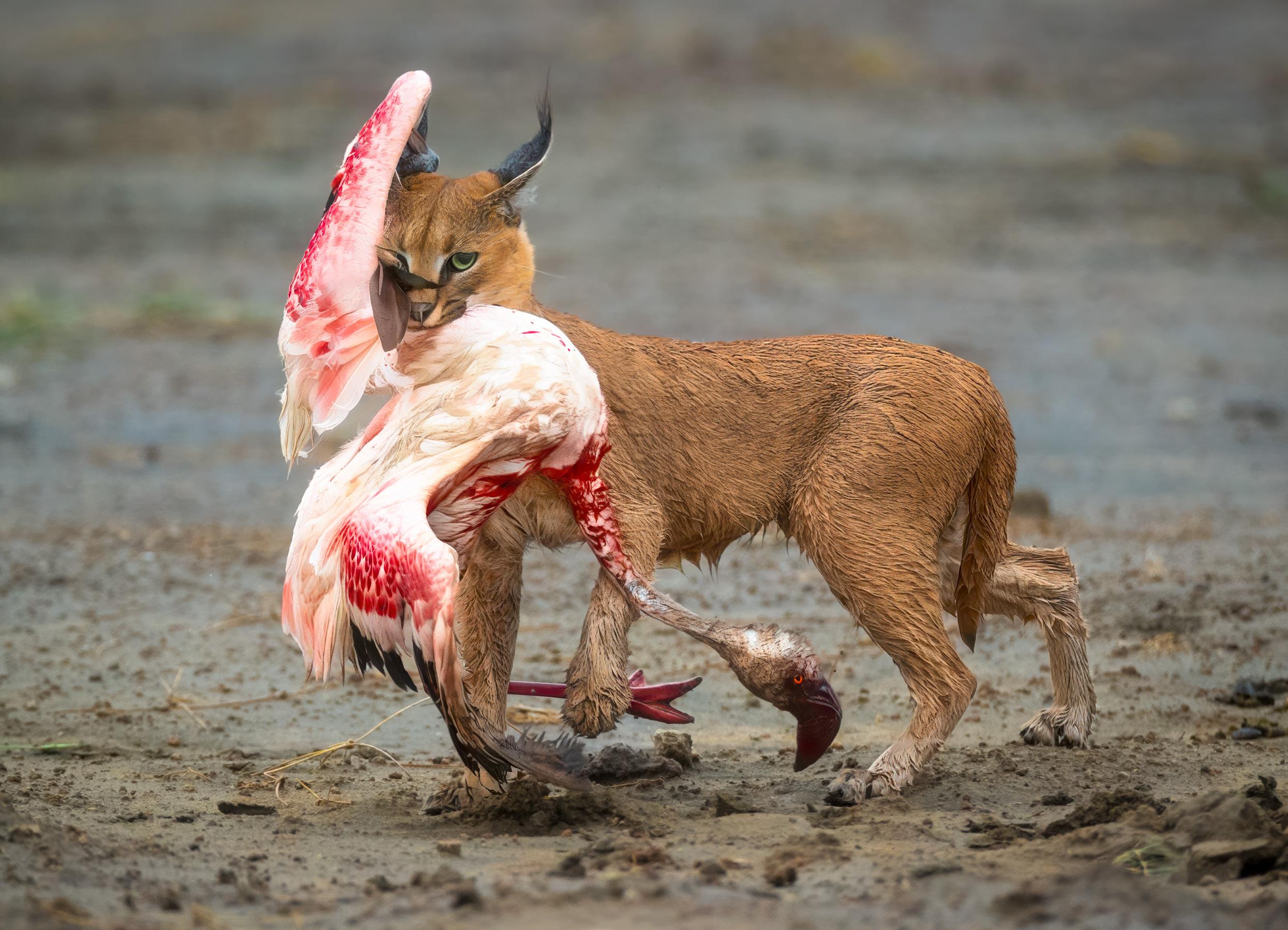
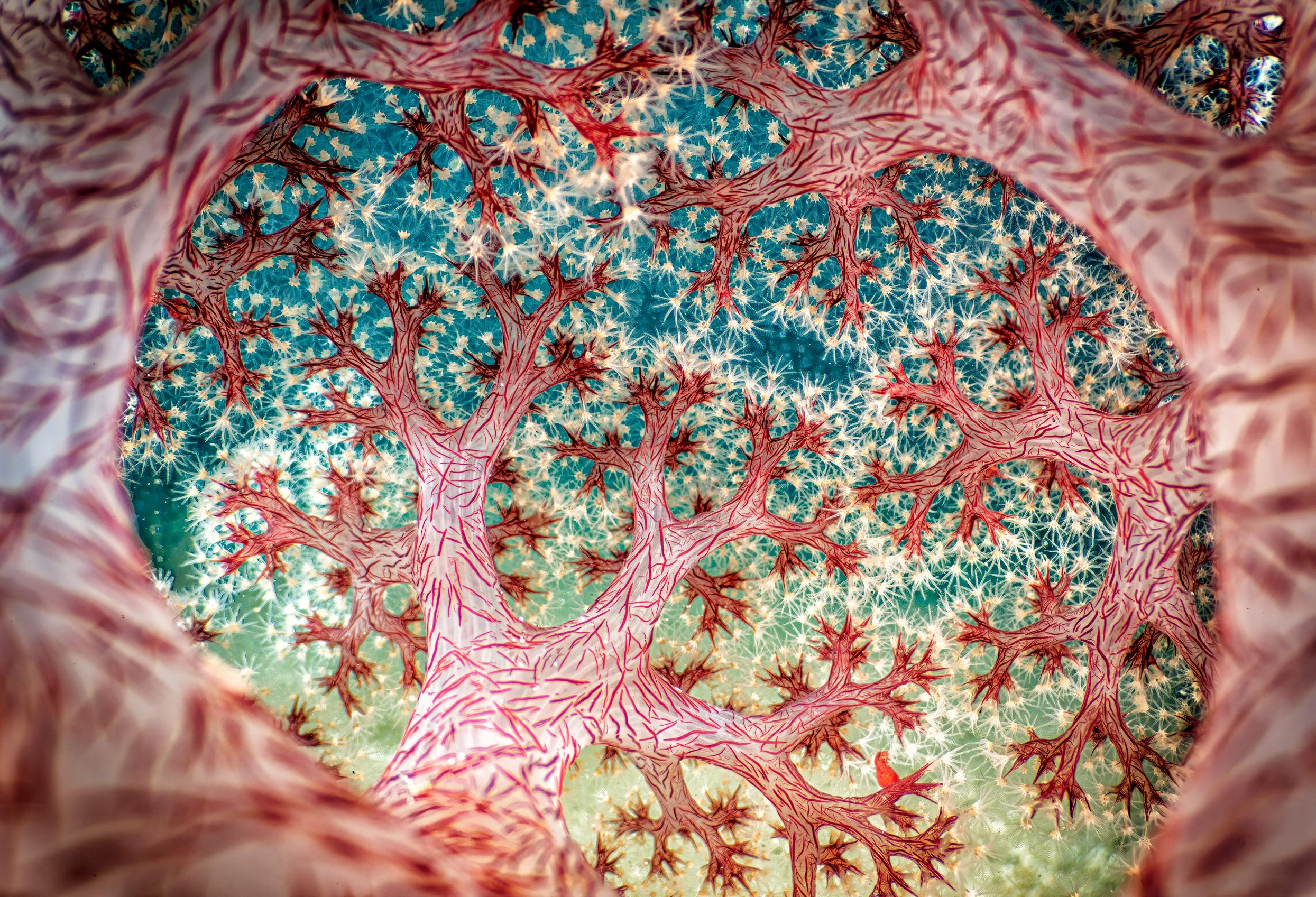
VISIT THE EXHIBITION AT THE MUSEUM
Wildlife Photographer of the Year 61 is open until Sunday 12 July 2026. Continue your journey online and discover the planet-positive actions you can take to protect the places and species you’ll see at nhm.ac.uk/wpy
Take home your favourite image from our print-on-demand facility outside the exhibition, or online at nhmshop.co.uk.
Members and Patrons receive free, unlimited entry and priority access to Wildlife Photographer of the Year and all paying exhibitions. To become a member, please visit nhm.ac.uk/membership.
If you would like to take part in the 2026 Wildlife Photographer of the Year 62 Competition you have until 11.30 (GMT) on Thursday 4 December 2025. For more information, visit nhm.ac.uk/wpy
Nuveen People’s Choice Award
Have your say by voting for your favourite image in the shortlist for the Nuveen People’s Choice Award. The annual award recognises outstanding competition entries as chosen by the public. Online voting opens on Wednesday 4 February 2026 and closes at 14.00 (GMT) on Wednesday 8 April 2026. The winner will be announced on Wednesday 15 April 2026. So, vote for your favourite by visiting nhm.ac.uk/wpy
Wildlife Photographer of the Year 2025 is owned by the Natural History Museum, London.

WILDLIFE PHOTOGRAPHER OF THE YEAR: PORTFOLIO 35
This portfolio book is a memorable collection of all the winning and commended photographs from Wildlife Photographer of the Year 61. For your chance to win one of five portfolios, just tell us who presented the Awards at the Museum in 2024.
To enter, send an email with your name, address and phone number, along with your answer, to magazine@nhm.ac.uk, putting ‘WPY’ in the subject line. Or post your answer to the address on page 3. Closing date is Saturday 28 February 2026.

Neanderthals were skilled tool users, relying on strength and precision to shape their world. Museum scientists are revealing the secrets hidden in their hand bones to provide a window into their daily lives.


EXPERT
We can’t know what happened when ancient Homo sapiens first met Neanderthals. Did we recognise them as fellow humans?
Certainly, they were walking on two feet, wearing clothing to protect against the cold, and carrying butchery tools… but maybe we would have focused on their differences. They were shorter than us. Stockier. Their hands were bigger, wider,

The dexterity and fine motor control of our hand is unparalleled in the animal kingdom. Combined with our big brains that can plan and imagine, our hands can produce and wield an extraordinary range of tools. From hammers to smartwatches, we manipulate, control and shape our world with objects. They allow us to prepare high-quality food, live in extreme environments, and bond us through artistic and cultural expression. Our hands are central to our humanity – but they’ve not always been unique to us. Our closest extinct relatives, the Neanderthals, were also sophisticated tool users and, like us, they relied on their hands to survive.
The similarities and differences between Homo and Neanderthals are evergreen questions for anthropologists, and how we use our hands offers a lens through which we can explore them. The archaeological record provides a rich archive of human-made objects, offering insights into the behaviours and cultures of past populations. But how does an anthropologist in the business of bones and fossils go about investigating these questions?
I’m a palaeoanthropologist who reconstructs behaviour from the bones of extinct human populations. I specialise in hand and wrist anatomy and have compared Neanderthal hands to those of Homo sapiens So what secrets do they hold about the daily lives of our extinct cousins?
Neanderthals are our closest extinct relatives.
From roughly 400,000 to 40,000 years ago, they lived across Europe and into southwest and central Asia. They were humans like us, but distinctive – a bit shorter and very muscular, with a large nose, a strong brow and a notably bigger head. Many of these differences helped Neanderthals survive in cold environments – their remains have even been found in Siberia. But they also lived in warmer regions such as Spain and Italy.
Like ours, the Neanderthal diet was hugely varied. Once thought to survive on a primarily meat-based diet, they are now known to have been flexible, eating whatever was readily available in their environment. When living in the colder northern latitudes, they relied more heavily on meat – but in southern latitudes they made good use of plentiful plants, such as fruits, mushrooms, tubers, lentils and grains.

There’s currently no evidence that Neanderthals ever made their way onto the African continent, but they did overlap with Homo sapiens in west Asia and Europe. During their roughly 5,000 years of coexistence in Europe, interbreeding events are known to have occurred. As a result, all humans alive today have around 1-4% Neanderthal DNA.
Imagine comparing the hand of a farrier – fitting steel horseshoes all day – to that of an anthropologist, like me, who spends their days typing. This would be pretty close to comparing a Neanderthal hand to that of an ancient Homo sapiens. Like the rest of its skeleton, the Neanderthal’s hand was massively muscular, with broad fingertips and a thumb that stuck out from the palm at a wide angle. This gave the hand impressive strength – but at a a price. Compared to us, Neanderthals likely had less fine motor control when positioning their thumb and fingers around objects. As a colleague once joked, ‘A Neanderthal might beat you in a thumb war, but you’d have the edge in speed and dexterity!’
Neanderthals crafted wooden spears that could kill prey a distance away, challenging earlier views that they could only catch prey up close.

Fossilised Neanderthal hand and wrist bones suggest major behavioural differences between the two human species. Their meaty hands and angled thumb were probably best suited to brute-force tasks that required a so-called power-grip – where fingers wrap around a tool and squeeze it into the palm. Think hammer, club Homo would have been better at tasks that require a precision-grip, such as slicing meat, sewing and woodworking – anything requiring you to pinch a tool
highlights differences in manual dexterity. The oldest occupations of Siberia dating to 40,000 years ago. These were used as they are today – to stitch fitted, tailored garments. This behaviour requires precision
To date, Neanderthals have never been found with eyed needles, but they’re regularly found with awls – a pointed tool made from stone or bone used to punch holes in leather. Based on this, it’s unlikely Homo
. Instead, Neanderthals probably fashioned animal hides into loose, poncho-like coverings. The advantage of tailored clothing over a cape is easy to imagine – the difference might feel like
The Neanderthal tool-making industry, called the
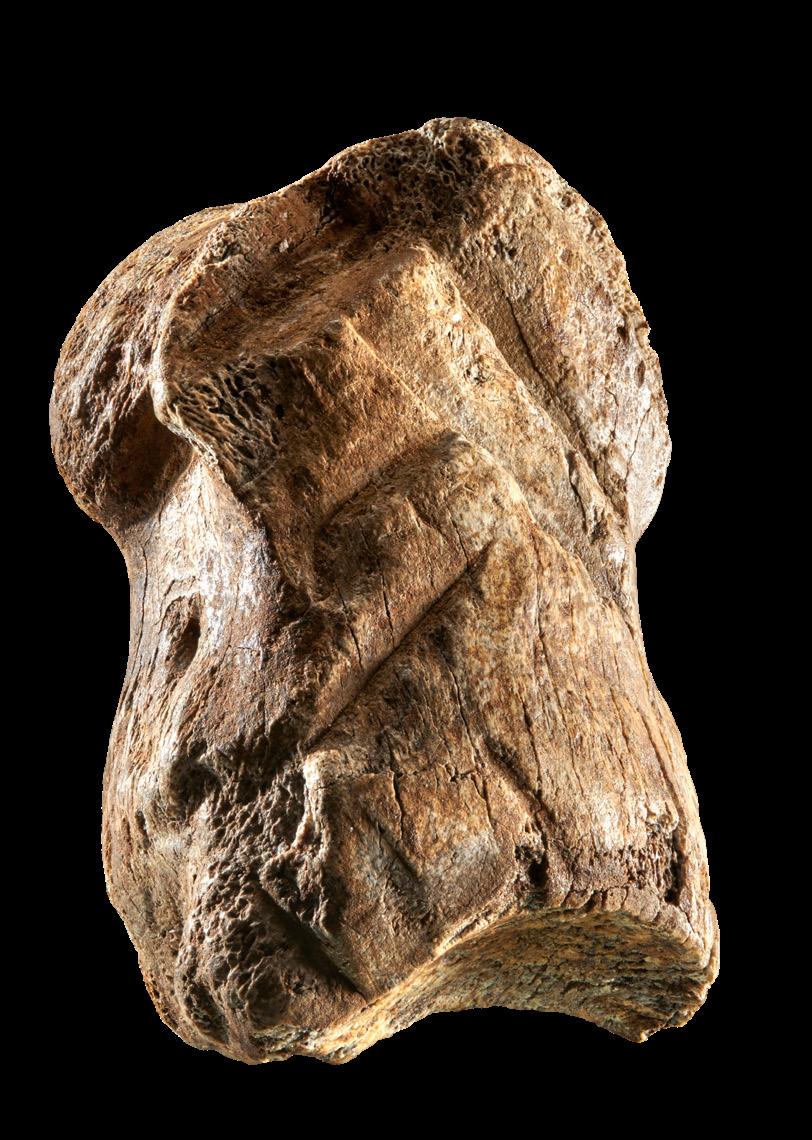
Above: This 51,000-year-old engraved deer bone reveals the Neanderthal’s capacity for symbolism.
Below: They also wore eagle talons as jewellery.


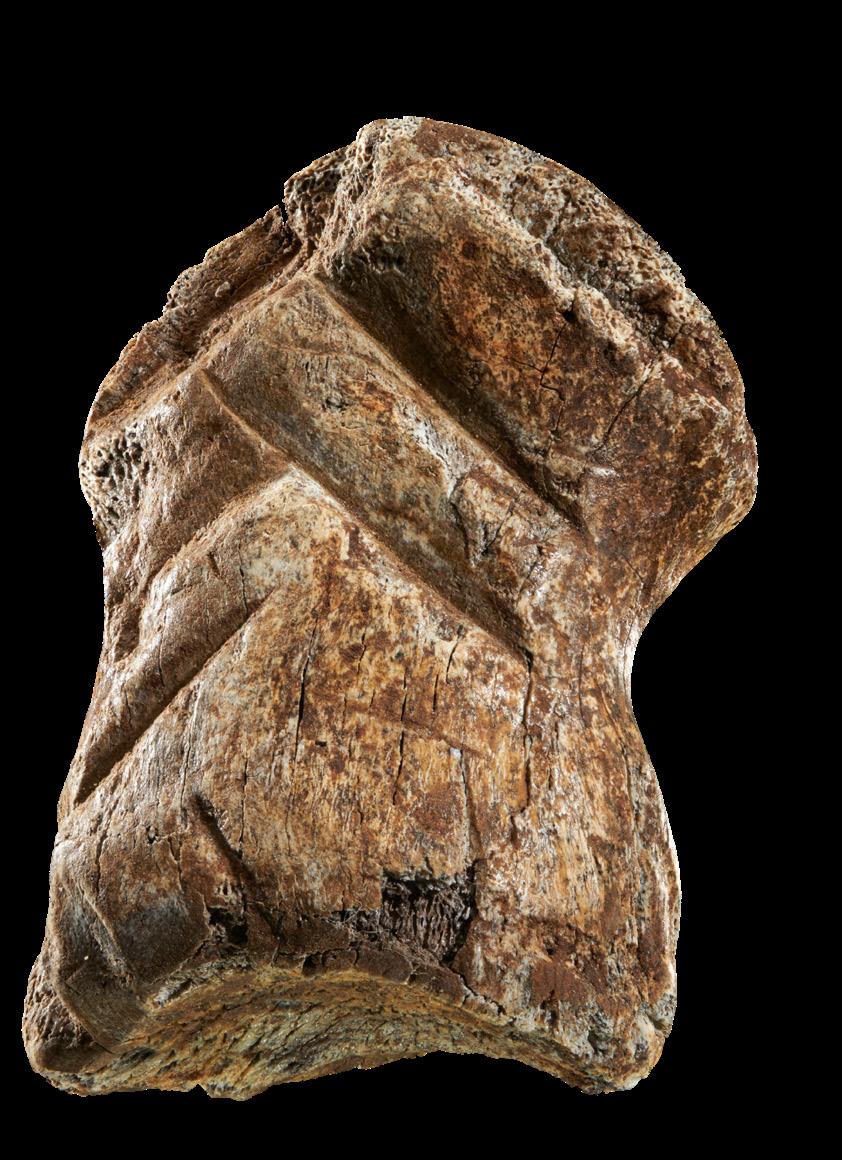
Silvia Bello, a specialist in prehistoric human behaviour at the Natural History Museum, studies the traces early humans left behind on both organic and inorganic materials.
These subtle marks – whether on bone, stone or antler – offer a vital bridge between the physical traces of manual activity and the cultural or symbolic meanings they may have carried. They help us see how hand use, cognition and creativity were often intertwined.
‘These objects provide a fascinating puzzle, revealing just how varied human behaviour could be,’ Silvia explains. ‘But the behaviours they represent can also feel extremely foreign to modern eyes.’ Have you ever been to a different country and found it tricky to decipher the unfamiliar road signs? Symbols are used constantly in our daily lives, but their meaning can be difficult to discern to an outsider of that culture – much like a twentyfirst century anthropologist researching the symbolic
meaning behind Neanderthalmade objects.
Sometimes, the challenge isn’t just interpreting the meaning of a mark, but appreciating the skill it took to make it. Some of the Neanderthal objects Silvia told me about suggest they might have had fine and delicate dexterity.
A recent excavation in the Harz Mountains, Germany, uncovered a rare, 51,000-yearold alpine giant deer bone. The bone was taken from the deer’s phalanx – what we would call our fingertip. It was prepared by scraping and possibly also boiling, before carefully carving stacked chevrons across its surface.
The bone is 70mm in length, while the chevrons are 13-29mm. They must have been made by a skilled Neanderthal using precise and controlled movements across the tiny piece of bone.
These traces of symbolic behaviour suggest that Neanderthals not only had the manual dexterity for fine tool use, but also the cognitive and social frameworks for abstract expression.
160,000 to 40,000 years ago – and disappeared from the archaeological record at the same time as the Neanderthals. Common tools included multipurpose handaxes used for butchery, hide preparation, digging and possibly fire starting. Sharp flakes were chipped off a larger stone to slice meat from bone, while specialised scrapers prepared hides or shaped wood and bone. Small, pointed tools were fashioned into spear heads and secured to spears using adhesives made from birch tar, bitumen and tree resin.
The oldest-known wooden spears come from Lower Saxony in Germany. Previously thought to have been made by Neanderthal ancestors Homo heidelbergensis, researchers now believe they’re a bit younger – between 200,000 and 300,000 years old – and may have been crafted by Neanderthals themselves. Carved from spruce, the spears are tapered at both ends, suggesting they were aerodynamic when thrown – much like a modern-day javelin.
The skeleton keeps the score
We know bones grow during childhood, getting longer and wider, but they don’t lose the ability to change as we age. The NHS recommends regular resistance and weight-bearing exercise to boost bone density and reduce the risk of osteoporosis. That’s because using your muscles increases bone density and strength, and this helps prevent fractures as we age.
These changes happen on a very local scale –for example, a tennis player’s dominant arm will have bigger muscle attachments and denser bone than their non-dominant one. This bone response to behaviour is called functional adaptation, and it gives anthropologists a valuable framework for reconstructing the behaviours of extinct species.
To analyse hand and wrist bone density, anthropologists use high-resolution X-rays. These scans are processed with medical software to map the variation in bone density across different anatomical regions, helping us understand how hands were used in life.
My recent research suggests Homo sapiens and Neanderthals both moved their wrists along a specific path called the Dart-Thrower’s Motion –the natural arc your wrist follows when miming a dart throw. From a biomechanical perspective, this motion enhances the use of certain tools, increasing the power and velocity of hammering and throwing without extra muscle effort.



Imagine trying to drive in a nail without moving your wrist – your whole arm strains and the movement feels stiff. Now let your wrist move naturally – it’s smooth and powerful, with a whip-like efficiency. That’s the Dart-Thrower’s Motion in action. The fact that Neanderthals
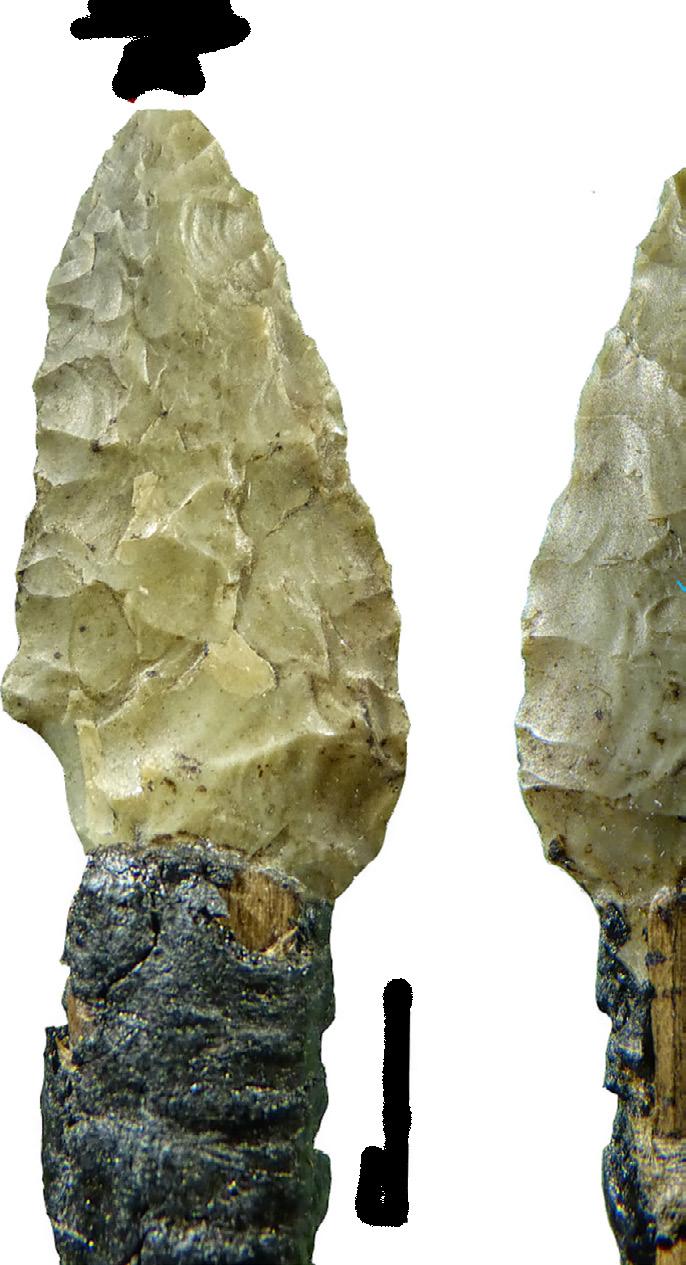
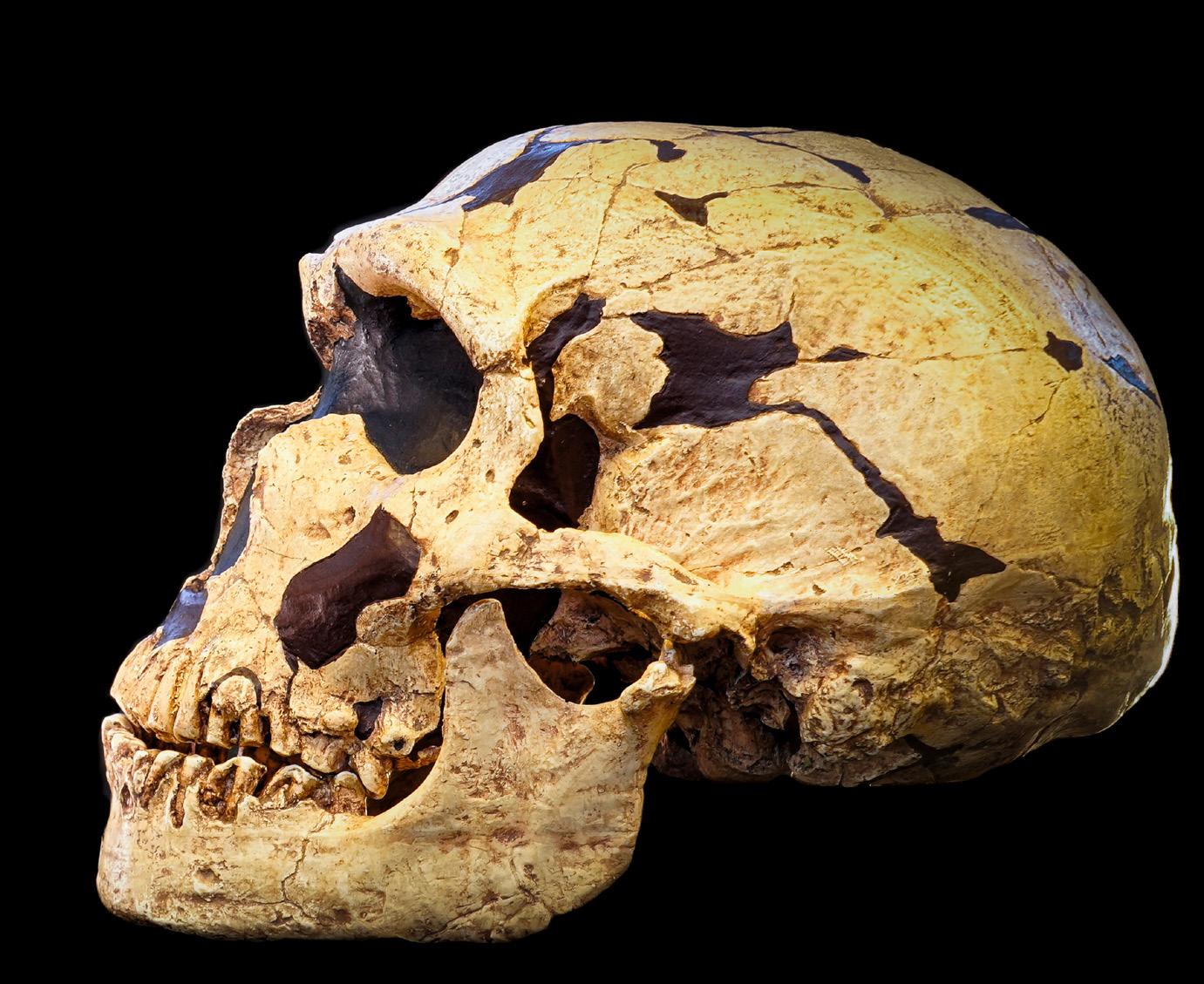

It’s likely that Neanderthal hands were less dexterous than Homo sapiens
used this action suggests it was also used by our last common ancestor, Homo heidelbergensis, indicating that this biomechanical adaptation to tool use has deep roots in our ancestry.
Moving up to the fingers, researchers from Tübingen, Germany, recently created elevation maps – much like topographical maps of a mountain range – of the finger muscle attachment sites in the hand. These map how the long and delicate muscles that control finger movement differ between the Homo sapiens and Neanderthals.
In Neanderthals, the muscles involved in pinch and precision grips were very large, which led researchers to conclude that they probably regularly used precision grips associated with fine manual dexterity throughout their lives. This research uses cutting-edge techniques, but some experts remain to be convinced.
Precision and power
In the end, the notable similarities between the tool kits of Neanderthals
and Homo sapiens suggest that both species used different grips and hand postures to make and use their tools. Nevertheless, differences in the hand and wrist bones mean it’s likely that Neanderthal’s hands were less dexterous than Homo sapiens’, reducing their mechanical efficiency for performing precision tasks, especially when using very small tools.
These types of tasks would have been slightly cumbersome for their big hands and taken more cognitive and physical effort. The small advantage –finding it easier to perform sophisticated precision tasks – adds up over time and may have given Homo sapiens a competitive advantage. It may also explain why Homo sapiens eventually developed more task-specific and ever smaller tools.
While the earliest depictions of Neanderthals suggested they were hunched, hairy, brutish and dim-witted cave dwellers, the more we learn about them, the more sophisticated they turn out to be. It’s clear that the roots of culture, adaptability and creativity stretch far deeper into the human family tree than once assumed.
Maybe that handshake would have been a little awkward, but their culture – their tools, clothing, jewellery and use of symbolism – would still have made them undeniably human. ●
The Natural History Museum’s Centre for Human Evolution Research (CHER) is generously supported by the Calleva Foundation.
An X-ray of a child’s hand with bone density mapped onto the
High bone volume is represented in red and low in blue.


The illegal wildlife trade is wide reaching and insidious, impacting thousands of endangered species. The Museum is working with forensic specialists to develop new techniques to help tackle the scourge of trafficking.

DID YOU KNOW?
Fingerprints on ivory usually vanish within days due to its porous surface – but Mark Moseley’s new kit extends detection up to 28 days, giving investigators more time to identify criminals.

At least 21 countries officially declared ivory stockpiles in 2020, totalling over 622 tonnes.

African elephants are, famously, the world’s largest land animals. Over three metres tall and weighing some six tonnes, the savannah species is a little heftier than its critically endangered forest cousin. But both face similar threats – particularly illegal hunting. It’s estimated at least 20,000 are killed every year for their tusks. Between 2007 and 2016, savannah elephant numbers plummeted by 30%. Now a new weapon has been developed in the fight against ivory trafficking. And it’s as minuscule as those elephants are enormous: a tiny magnetic particle no bigger than 40μm in diameter – 50 times smaller than a pinhead.
The use of ultrafine powder is the brainchild of Mark Moseley, Specialist Forensic Photographer with the Metropolitan Police, whose spare-time passion is tackling wildlife crime, applying his expertise, knowledge and curiosity. That curiosity was piqued when he encountered customs officials holding an elephant tusk. He realised that various people had touched it –
poachers, traffickers and others in the trade chain. Surely they had left fingerprints?
‘Unpolished ivory may seem like the perfect surface from which to obtain prints,’ he notes. ‘But in practice it was almost impossible to make out any fingermarks that were over seven days old.’ Why? And how could that problem be solved?
‘Working with Dr Leon Barron [formerly in the Forensic Department at King’s College London, now at Imperial University], we examined the surface of ivory using a scanning electron microscope,’ he explains. ‘The cementum – the thin outer layer –looks like a sponge, pocked with tiny pores into which the liquids comprising fingerprints seep. I realised that very, very fine powder would settle into these holes, potentially allowing us to detect ridge detail in a print for much longer.’
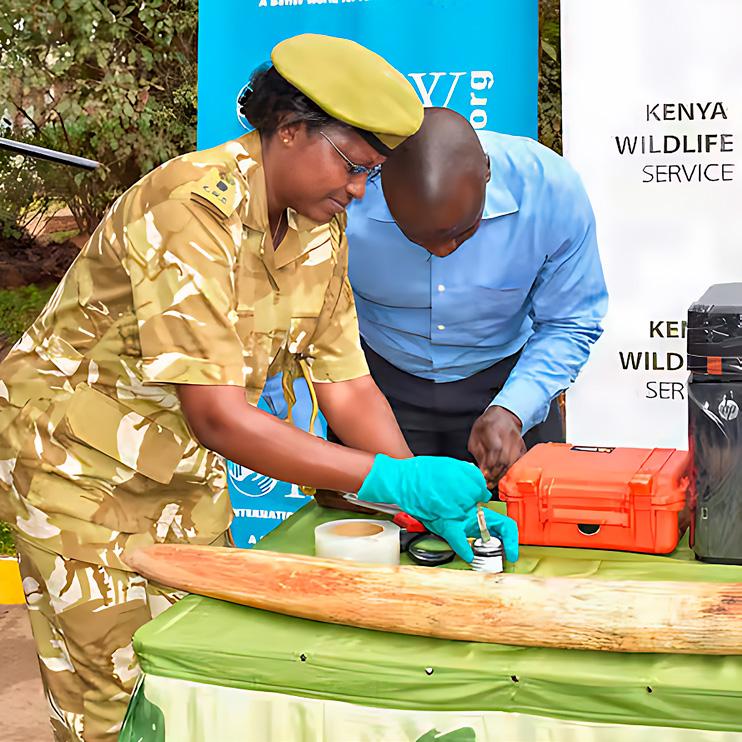
The new fingerprinting kit is now being used by the Kenya Wildlife Service to tackle poaching.
Conventional fingerprinting powder has diameter over 100μm. So Mark and his collaborators tested a dozen recently launched ultra-fine powders. ‘We realised that magnetic powder would be handy, because it can be picked
Above left
Despite bans, global ivory stockpiles persist, with countries like Kenya and China holding tens of thousands of kilos –some destroyed to deter trade, others still at risk of leaking into illegal markets.
Above right
Every year, over 20,000 African elephants are illegally killed for their tusks, fuelling a black market worth up to $2 billion.


up with a magnet and reused,’ he adds. ‘It’s also available in two colours: black for ivory, and white for darker surfaces such as rhino horn.’
Using the new powder, ridge detail can be visible up to 28 days after a fingerprint is made – a huge leap forward. It’s also cheap and easy to use by anyone familiar with standard fingerprinting techniques. To put his discovery into practice, Mark collaborated with David Cowdrey, then Head of Policy and Campaigns at International Fund for Animal Welfare (IFAW).
‘If you can obtain identifying fingerprints from confiscated ivory, you can link it directly to a smuggler or poacher. But historically it’s been almost impossible to get usable detail,’ says David. ‘I immediately recognised the potential of Mark’s discovery, and started work to produce field kits containing the powder.’
In its tough dustproof case, each kit includes a magnetic wand that acts like a brush, two bottles of powder, scissors, lifting tape, rubber gloves, evidence bags, pens and a magnifying glass. More than 250 were produced and distributed around the world by IFAW. ‘We initially provided four kits to the Kenya Wildlife Service,’ says David. ‘It quickly helped secure evidence in four cases resulting in 15 arrests, and the seizure of 11 elephant tusks and 50 pieces of worked ivory.’ →

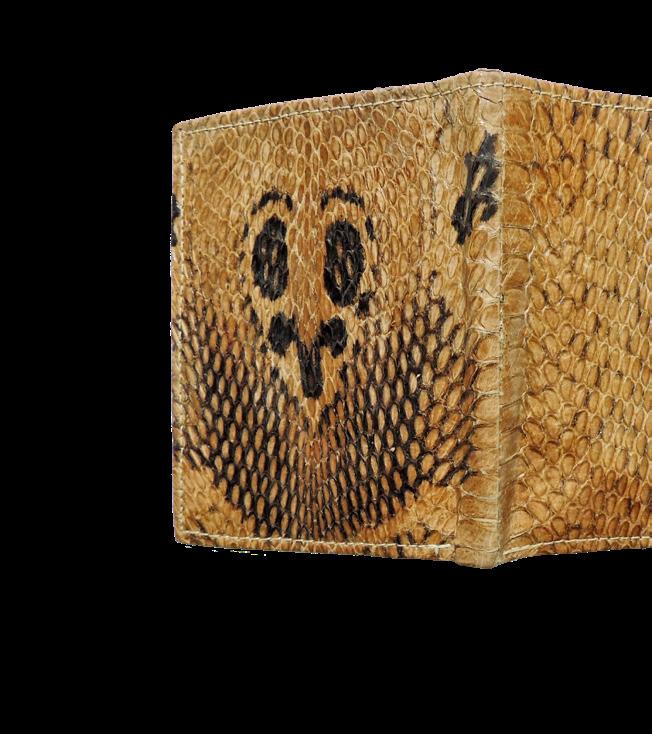

EXPERT
Mark Moseley
Mark is a Forensic Imaging Expert for the Metropolitan Police Service, who, in his spare time, researches forensic applications to help identify criminals linked to wildlife crime.

MUSEUM EXPERT
Roberto Portela Miguez
Roberto is Principal and Senior Curator in Charge of Mammals at the Museum. His responsibilities include the management and study of the collection under his care.
The global trade in reptile skins for fashion is big business, worth an estimated US$600 million in 2018. Many animals are reared in captivity for this – but how can Border Force staff recognise products made from the 1,190 reptile species protected by CITES (Convention on International Trade in Endangered Species)? To help, an AI-powered model was being developed by Museum and scientists from ZSL (Zoological Society of London).
‘The team photographed and digitised hundreds of processed skins, handbags, shoes and other items in the Museum, ZSL and the Metropolitan Police collections,’ explains Dr Arianna Salili-James, Senior Machine-Learning Researcher. ‘The dataset was expanded with images from the international online network Global Biodiversity Information Facility.
Altogether, thousands of images were used to train a machine-learning model to recognise shapes and patterns in the skin of critically endangered and commonly traded snake species.
‘We hope to create an app for Border Forces to use,’ Arianna continues. ‘It will analyse camera phone photos of suspect items to accurately and rapidly spot illegally trafficked and threatened species.’


Investigators can recover fingerprints up to 28 days old from ivory, potentially revealing every person who has touched the tusk.


could study gorillas’ characteristics and apply the same techniques I already use.’
Again, that meant fingerprinting. Such characteristic ridge details are found only in primates and koalas; as in humans, each gorilla’s print is unique to that individual.
‘My idea was that every gorilla reintroduced into the wild or sedated in captivity could have their fingerprints digitised and stored on an internationally accessible database,’ recalls Mark. ‘If hands or feet turn up in, say, Vietnam, police or

with those on the database and potentially identify where that gorilla came from – perhaps even the troop to which that individual belonged. An evidential trail could be created to find out who was involved in taking and smuggling them.’
To develop this concept, Mark needed to trial digitisation of hands in various states. ‘You can get wonderful results from live gorillas,’ he says, ‘but trafficked hands are often damaged or slightly decomposed. We had to study specimens that were not in 100% pristine condition.’ So he contacted Roberto Portela Miguez, Principal and Senior Curator in Charge of Mammals at the Museum.
Mark worked with museum specimens and zoo animals to refine his forensic techniques.
Above Mark’s breakthrough dramatically extends the forensic window for identifying poachers and tracing illegal trade routes.
Below Mark documents the fingerprints of sedated gorillas during veterinary procedures at Chessington Zoo, for a database to protect great apes in the wild.



‘We went through Museum collections, looking at mounted taxidermy, skins and specimens preserved in fluids,’ says Roberto. ‘Taxidermy specimens may have been infilled, stretched or distorted during preparation, depending on the methods used. Sometimes they’re even coated with paints. Wet specimens are less deformed.’
‘Nine Museum specimens were used to test the technique,’ Mark continues. ‘We then moved on to live animals. In total we studied 38 gorillas, including some sedated at London Zoo, building up a close relationship with the Zoological Society of London and GRASP (Great Apes Survival Partnership).’
Again, the technique had to be simple, cheap and accessible worldwide. ‘I decided to use mobile phones because everybody has one,’ explains Mark. ‘But many phone cameras have a shallow depth of field: they must be square on to the fingerprint in order to capture a suitable image. So we created a simple page of visual instructions, with rulers for measuring hands and graphics drawn by my daughter, Mia, [an illustrator], showing how to take a useable photograph.’
The aim is to compile a remote database of prints from gorillas in zoos worldwide. Crucially, once images are taken – whether in a zoo or in the wild in Central or East Africa – they’ll be immediately uploaded. ‘We aim to create a deterrent,’ adds Mark. ‘We want poachers and
wildlife hunters to be put off killing gorillas or trafficking parts. We also want to keep rangers and park staff safe, as they’re potentially dealing with criminal activity. So it’s important to build awareness that photos aren’t stored on rangers’ phones: there’s no point snatching those phones or breaking into park property to remove that data.’
Depending on the species, creating a database containing the fingerprints of all known individuals isn’t out of the question. ‘Numbers of wild gorillas, chimpanzees and some other apes are low – at a subspecies level there may be only a few hundred individuals left,’ observes Roberto. ‘There are fewer than 300 Cross River gorillas surviving in the wild, for example.’ The collaborators hope to publish their work soon and roll out the process, though the technique has already been trialled successfully in Cameroon.
The Museum’s involvement has been vital, as in so many other areas of research. Scientists are constantly mining the Museum’s 80 million-plus specimens – rapidly being digitised and shared online – for data and discoveries. ‘Well over 200 years after the collections were first established, specimens are still yielding novel insights and, crucially, solutions to the urgent challenges faced by wildlife,’ says Roberto. ‘And we continue to develop techniques for maximising these resources: AI applications, chemical and molecular methods, and many new ways of looking at historical specimens – constantly reimagining, reinventing and reassessing their potential.’ ●
body
Mark was assisted in his gorilla research by colleagues from the Metropolitan Police Forensic Services, Jo Dunphy (Forensic Examiner), Hazel Fransch (Quality Manager) and Vivienne Hann (Senior Reporting Fingermark Examiner).
WATCH THIS
Join Roberto and Mark for an eye-opening Dig Deeper talk on wildlife crime and Mark’s new technique. bit.ly/dig-deeperwildlife-crime
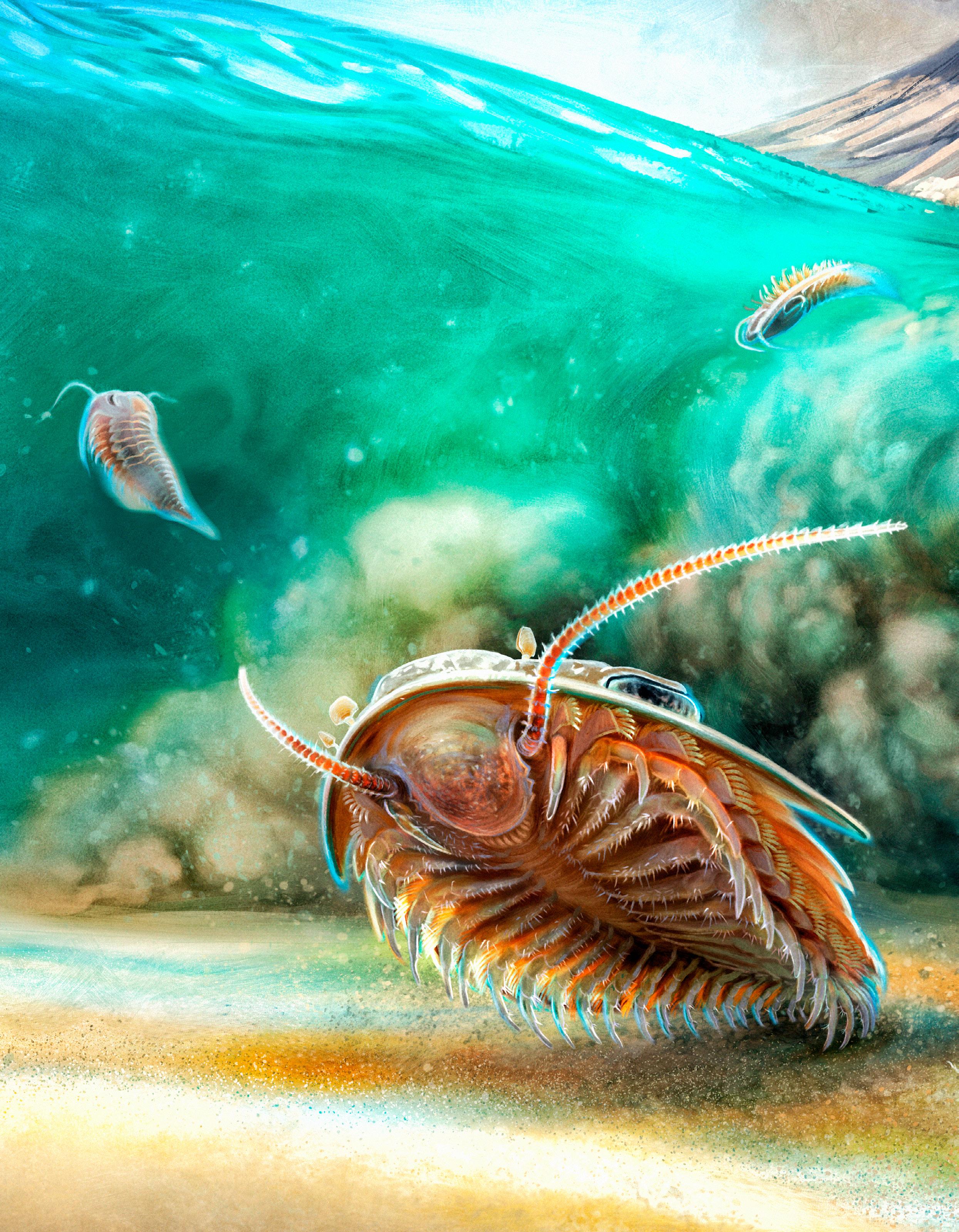
The ‘Pompeii trilobites’ were preserved in astonishing detail by a prehistoric volcanic blast.
Shape-shifters and time travellers, trilobites flourished in Earth’s oceans for 270 million years. Scientists at the Museum have led the way in uncovering their secrets and the valuable insights they hold into the forces that shape life on Earth –past, present and future.
WORDS: DR GREG EDGECOMBE

Few fossil invertebrates capture our attention as much as trilobites. They are ancient, being the first arthropods – jointed-legged animals, including insects, crustaceans, arachnids and millipedes – in the fossil record. After their appearance in Cambrian rocks some 520 million years ago, they went on to populate the world’s oceans all through the Palaeozoic Era, proliferating into more than 22,000 species.
That diversity encompasses a phenomenal range of forms and body sizes, from less than two millimetres to more than 90 centimetres. They are smooth or spiny, may have few body segments or over 100, and seem to gaze back at us with compound eyes comprising anything from dozens to thousands of lenses.
Trilobites have so many species and are known from so many specimens (for some species we have thousands of specimens in collections) in part because their hard, mineralised exoskeleton enhanced the likelihood that they would be preserved as a fossil. A trilobite effectively lived in a tank, the upper side of its body a calcite armour composed of three lobes (thus the ‘tri-‘ and ‘lobe-‘ in trilobite).
Like other arthropods, trilobites moulted, periodically shedding their exoskeleton to grow. This means that an individual trilobite had multiple opportunities to leave a fossil. This tremendous number of species and often stunningly wellpreserved specimens make trilobites an especially useful source of data for investigating questions about diversification and extinction in the Palaeozoic Era.
The trilobite menagerie has long attracted keen collectors as well as academic palaeontologists. Of them all, no other scientist has contributed as much to our understanding of trilobites as the Museum’s Richard Fortey, whose research shaped modern interpretations of their evolution, ecology and significance in Earth’s history.
Richard specialised in trilobites from the Ordovician Period (487 to 443 million years ago), but the hundreds of new species he described came from all periods of the Palaeozoic and from all around the globe. Back then, the configuration of continents and oceans was very different from today; for much of the first half of trilobites’ existence, the continents were mostly dispersed around the equator in shifting marine environments.
As the plate tectonic revolution took hold in geology, with the realisation that the Earth’s →
This cluster of Dikelokephalina brenchleyi was buried in silt nearly 480 million years ago.

surface is composed of mobile plates and terranes (fault-bounded areas), research on trilobites provided vital insights into how ocean basins formed and closed during the Palaeozoic.
Richard observed that some trilobites were precise indicators of only one geological terrane, whereas others spanned large parts of the world and different palaeoenvironments. This was because these ‘globetrotters’ were swimmers, with streamlined bodies and wrap-around visual fields that allowed them to see up, down and around the water column.
Gleaning clues
These kinds of inferences about the life habits of trilobites are made by combining information about the ecology of living arthropods that have similar forms, with environmental data (such as water depth and oxygen levels) from the sediments in which the trilobites were fossilised, and sometimes with behavioural evidence from trace fossils (impressions trilobites left behind when they walked on or burrowed in the seafloor).
Like living marine crustaceans, the diversity of trilobites is reflected in highly varied modes
of feeding. Richard identified that some trilobites were predators or scavengers, others were sediment eaters (known as deposit feeders), while the rest were filter feeders, collecting nutrients from water circulating in a filtering chamber under their head shields.
Sometimes insights into the anatomy and life habits of trilobites come from unexpected sources. This was certainly the case when I joined a team in 2023 to work on what have come to be known as the Pompeii trilobites.
Picture a Cambrian seascape in what is now Morocco. Trilobites a few centimetres long walked
Above Clusters of the same species of similar (adult) size are often interpreted as mating gatherings, just like many living marine arthropods.
Below With towering crystal eyes stacked like watchtowers, Erbenochile erbeni used its extraordinary vision to scan ancient seas in all directions.
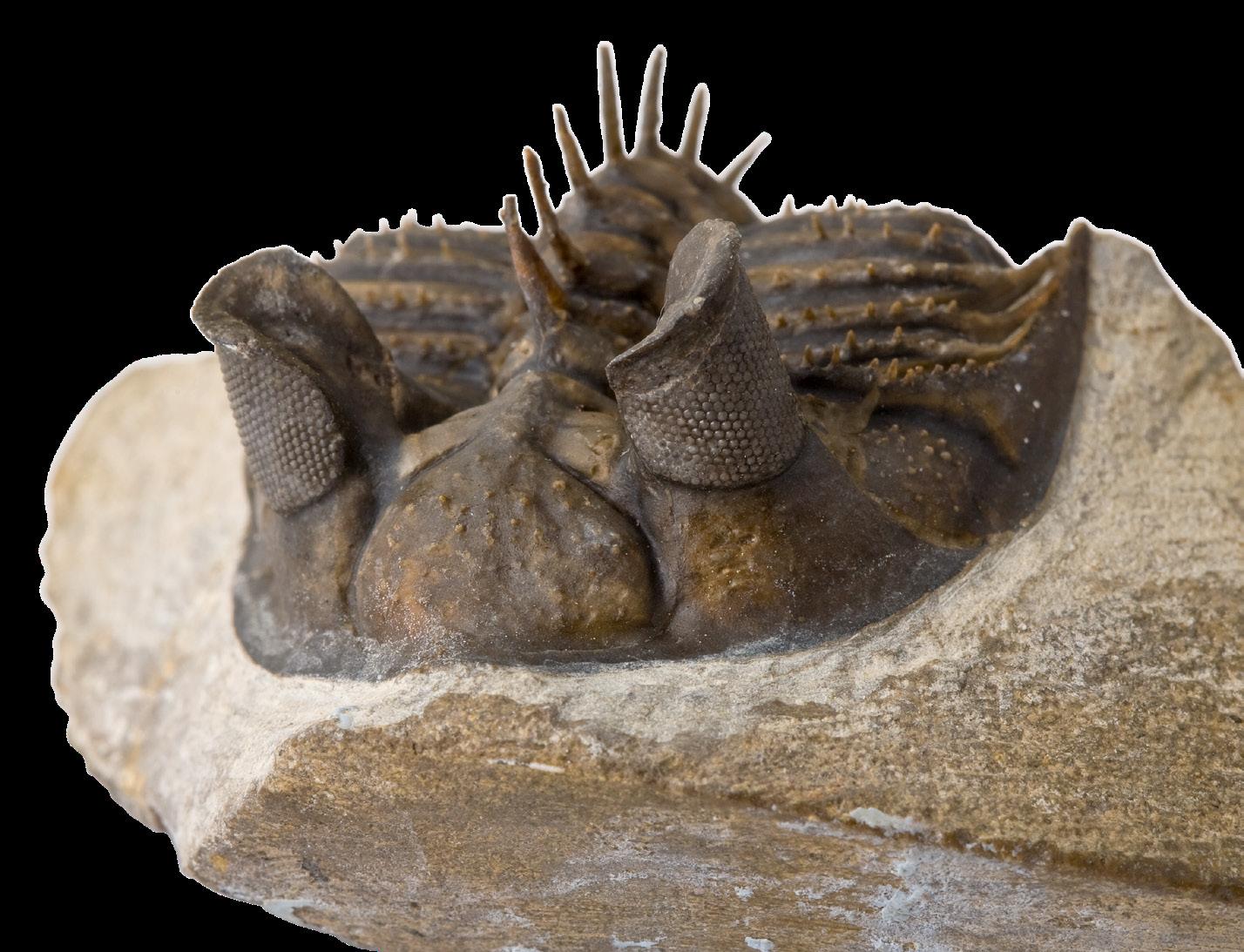


on the seabed near the shore, 510 million years ago. A volcanic eruption triggered a flood of volcanic ash into the sea. The trilobites were killed instantly, but remineralisation caused by glassy ash interacting with seawater caused the outline of their exoskeletons – as well as their antennae and other appendages – to be moulded in three dimensions, very close to their positions in life. Even small lampshells (brachiopods) that were attached to the trilobites in life were preserved with their attachment stalks intact.
These trilobites and their hitchhikers are almost pristine – and as lifelike as Vesuvius’ victims at Pompeii – but what we’re actually seeing is the empty space where their anatomy was obliterated. An exception was the gut, which was preserved in 3D because it was filled by volcanic ash, likely ingested in the instant before the trilobite died. Fortunately, this combination of volcanic rock and void space (literally, air) is ideal for computed microtomography, which uses X-rays for imaging. By scanning thousands of slices through the trilobites and the surrounding volcanic rock, it was possible to make 3D models of the specimens’ anatomy.
The models revealed that trilobites have one more pair of head appendages than expected – we’d not been able
An artist’s impression of trilobites moving about on the bottom of a warm Paleozoic sea.

DID YOU KNOW?
Trilobites were among the first animals to develop complex eyes – some species boasted 5,000 lenses per eye, made from pure calcite. These crystal eyes gave them superb underwater vision.
Four species of the trilobite Walliserops, all from the Devonian of Morocco, share a three-pronged pitchfork-like projection from the front of their headshield. In its most extreme variant, the three prongs are at the end of a stalk as long as the rest of the head. In a study with palaeontologist Alan Gishlick, Richard Fortey compared the similarly elaborate ‘horns’ of rhinoceros beetles to the trilobite trident. They concluded that males of Walliserops could have used their tridents as sexual combat weapons.

MUSEUM EXPERT
Dr Greg Edgecombe
I’m a palaeontologist and systematic zoologist, a researcher in the Invertebrates and Plants Palaeobiology division. When not investigating trilobitelike fossils, I work on centipedes.
In 2015, I joined three palaeontology colleagues from the Museum to collect Cambrian fossils in the desert hills of Nevada, USA. We were in search of ‘softbodied’ fossils like those from the Burgess Shale of Canada, where marine animals like Opabinia and Anomalocaris are well-known to fossil enthusiasts and often featured in museum displays and outreach materials.
Top, right
These Triarthrus eatoni offer a rare glimpse into the life of an Ordovician trilobite nearly 445 million years ago.
Far right
One of Richard Fortey’s important contributions was to reclassify trilobites by evolutionary lineage, revealing their diverse habitats from coasts to deep seas.
Our shales contained trilobites as well, but more beautiful specimens came from digging in slightly older rocks. These belong to the family Olenellidae, the evolution and extinction of its species being the basis for a series of trilobite zones that help date Early Cambrian rocks in North America with remarkable precision.
In our field site, six species of olenellids disappear from the geological record abruptly, and this is identified as the last record – and extinction – of the family. We can literally point to when the extinction happened in the field, marked by a narrow horizon of fossil absence. This olenellid extinction in North America is closely followed by the extinction of a different group of trilobites, the redlichiids, in China and Australia.


to see them in the best specimens flattened in shales. At the sides of the mouth is a tiny pair of appendages with only one of the two branches seen in the other appendages (and in this case the branch looks like an antenna rather than the usual flap). The mouth is slit-shaped and was revealed more clearly than we had seen before in a trilobite. The mouth opens on a fleshy lobe that had also escaped discovery before. This soft-tissue lobe, which we determined was the labrum (‘upper lip’) of living arthropods, attaches to the back of a tough plate under the head called the hypostome.
These findings provided new data for interrogating a question that has vexed palaeontologists for over a century: we know that trilobites are arthropods, but what are their closest living relatives? Are they more closely related to horseshoe crabs (and spiders, mites and scorpions) – the chelicerates –or are they closer to crustaceans, insects and millipedes, known as mandibulates?
Rare and striking, Early Cambrian trilobite Olenellus fowleri boasts a broad, spiny head and tightly set eyes.
With living species, we can use DNA sequence data to infer evolutionary interrelationships, but with ancient fossils like trilobites
Preserved in pyrite like ancient gold leaf, Triarthrus eatoni reveals its soft anatomy in stunning detail – legs, antennae, and even eggs.

we need to rely on their preserved anatomical details. The battery of prey-shearing spines along projections from the inner edges of trilobites’ appendages, seen beautifully in the Moroccan ‘Pompeii’ specimens, suggests an affinity to marine chelicerates. On the other hand, a single pair of antennae and details of the compound eye steer them towards the mandibulates. We wracked our brains over whether the labrum and mouth in our trilobites might help to resolve this conundrum. Our conclusion was that trilobites shared traits common to both living groups, together with having some traits of their own, but a ‘magic bullet’ character that could finally settle the place of trilobites in the arthropod tree remains elusive. Our ‘Pompeii’ trilobites perished and were fossilised
This article is a tribute to the memory of Richard Fortey OBE FRS FRSL, whose legacy continues to enlighten our understanding of ancient life and the natural world around us.

in a geological instant in the Cambrian. Their relatives would survive for another 260 million years, providing palaeontologists with fossil data that today help us build time scales to correlate rocks, learn how new species originate, and understand mass extinction and recovery. I’ve devoted 40 years to studying trilobites for these scientific reasons, but I’m also drawn to them for the same reasons that so many people love and collect them. They’re both familiar, yet far-away in time. ●
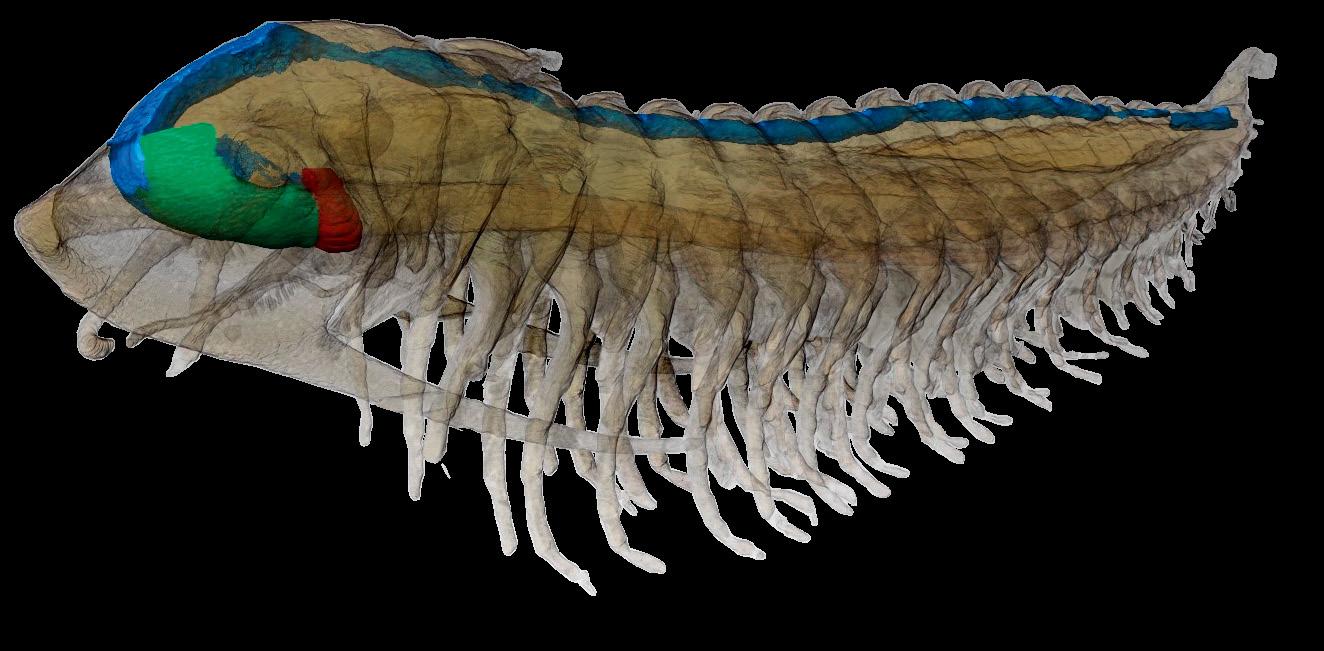
A 3D scan of the trilobite Protolenus (Hupeolenus) reveals its digestive tract in blue.
Most shark bites are probably due to mistaken identity. Surfers and swimmers look like seals when viewed from below. Once a shark realises its mistake – often after a single exploratory bite – it typically retreats.


As blockbuster Jaws celebrates its 50th anniversary, Museum scientist Dr Diego Vaz debunks the myths perpetuated by the movie, reveals how real great white sharks behave, and advocates for replacing fear with respect.
WORDS: JAMES ASHWORTH
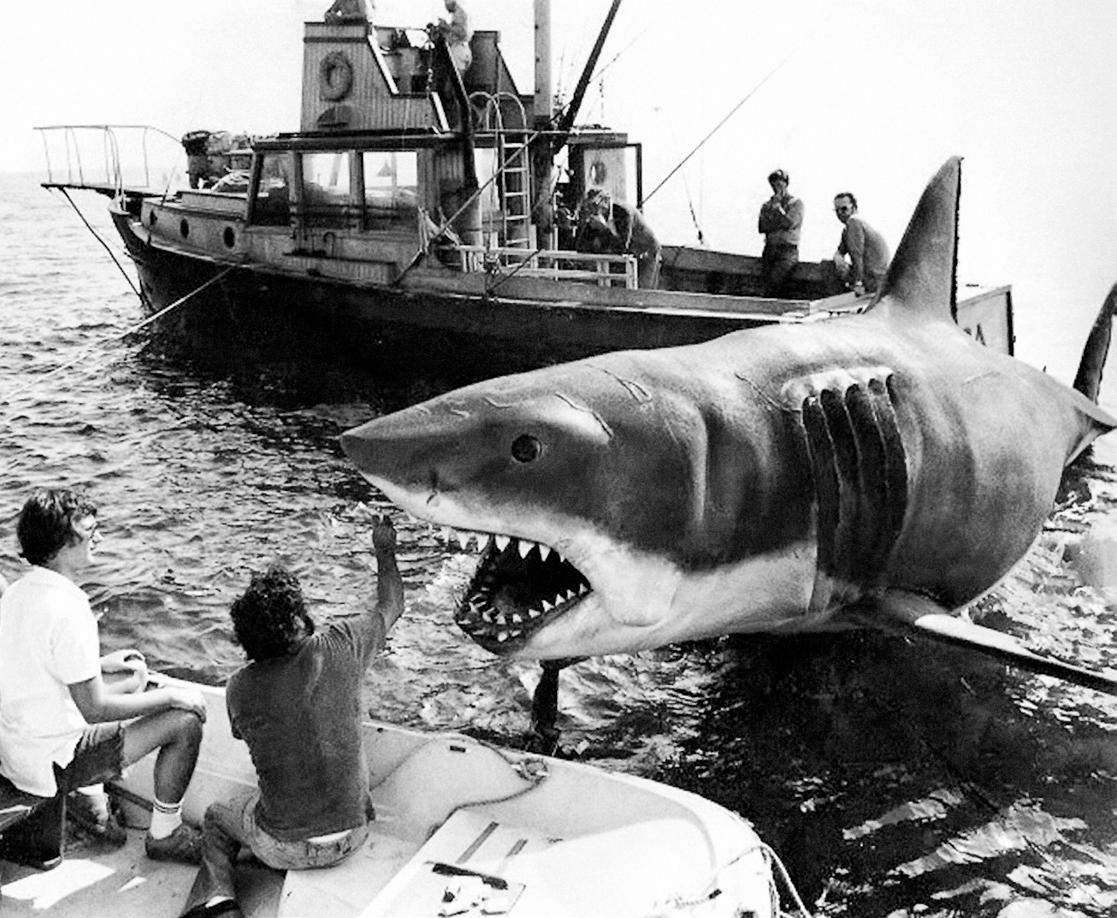
Fifty years ago, Jaws swam into cinemas and made a mighty splash, becoming one of the highest grossing films of all time. The tale of a great white shark menacing the small town of Amity Island is generally regarded as a landmark in cinematic history, setting the template for blockbuster films that continues today. But while the cinematic legacy of Jaws is rightly recognised, its impact on sharks is much less laudable.
The film gave sharks a reputation as merciless and vindictive, driving mass hunts along the North American coast. While great whites can certainly be dangerous, they’re much more interested in eating seals than they are in attacking humans. To mark Jaws’ 50th anniversary, it’s time to take a deep dive into what the film got wrong about sharks, and why these animals don’t deserve their killer reputation.
Great whites don’t play with their food
In the opening scene, the unfortunate Chrissie Watkins takes a late-night swim, only to be →
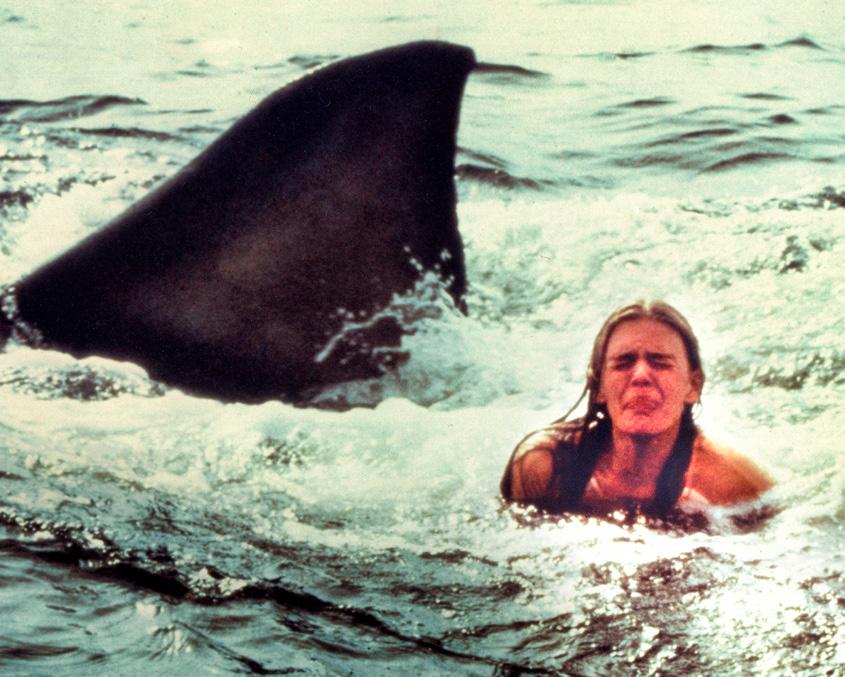
dragged around the surface of the ocean and pulled beneath the water. Chrissie’s remains are discovered the next day, having become the first victim of Jaws’ shark.
Sharks don’t drag prey around theatrically, as in Jaws. Their hunting involves a quick strike then retreat.
While the scene is a portent of things to come, it doesn’t really reflect how great white sharks hunt in real life. Dr Diego Vaz, our Senior Curator of Fishes, says that sharks aren’t known for dragging, or drowning, their prey.
‘Great whites hunt in a variety of ways designed to guarantee their prey won’t harm them,’ Diego explains. ‘A common method used when hunting seals is to leap out of the water. The shark strikes the seal from below, at high speed, aiming to grab the animal between its jaws. Another technique is to bite chunks out of their prey and allow it to bleed to death. They then return to the animal and carry it away to feed on.’
Jaws turned beachside bliss into deep-sea dread – Brody’s fear of the ocean became everyone’s.

The attack on Chrissie is unlikely – it’s rare for a shark to take more than one bite out of a human

Great whites rarely attack humans
The attack on Chrissie is also unlikely for another reason – it’s extremely rare for a shark to take anything more than a bite out of a human. It’s not really known why this happens, but one of the leading theories is a case of mistaken identity.
‘Dinosauria’. Image from
Though sharks have finely tuned senses that enable them to detect everything from electrical signals to pressure changes, their eyesight isn’t actually that detailed. Research suggests sharks aren’t very good at seeing fine details or colour –in fact, they might be completely colourblind. Instead, their eyes are adapted for detecting contrast, which allows them to better pick out the movement of prey against the background.
While great whites have some adaptations to improve their vision near the surface, research suggests that juveniles, at least, can’t see any difference between surfers, swimming humans and seals in motion. This means hungry sharks might have already taken a sample bite before their other senses kick in and they realise they’re biting
As apex predators, sharks regulate prey populations and maintain the balance of the food web.
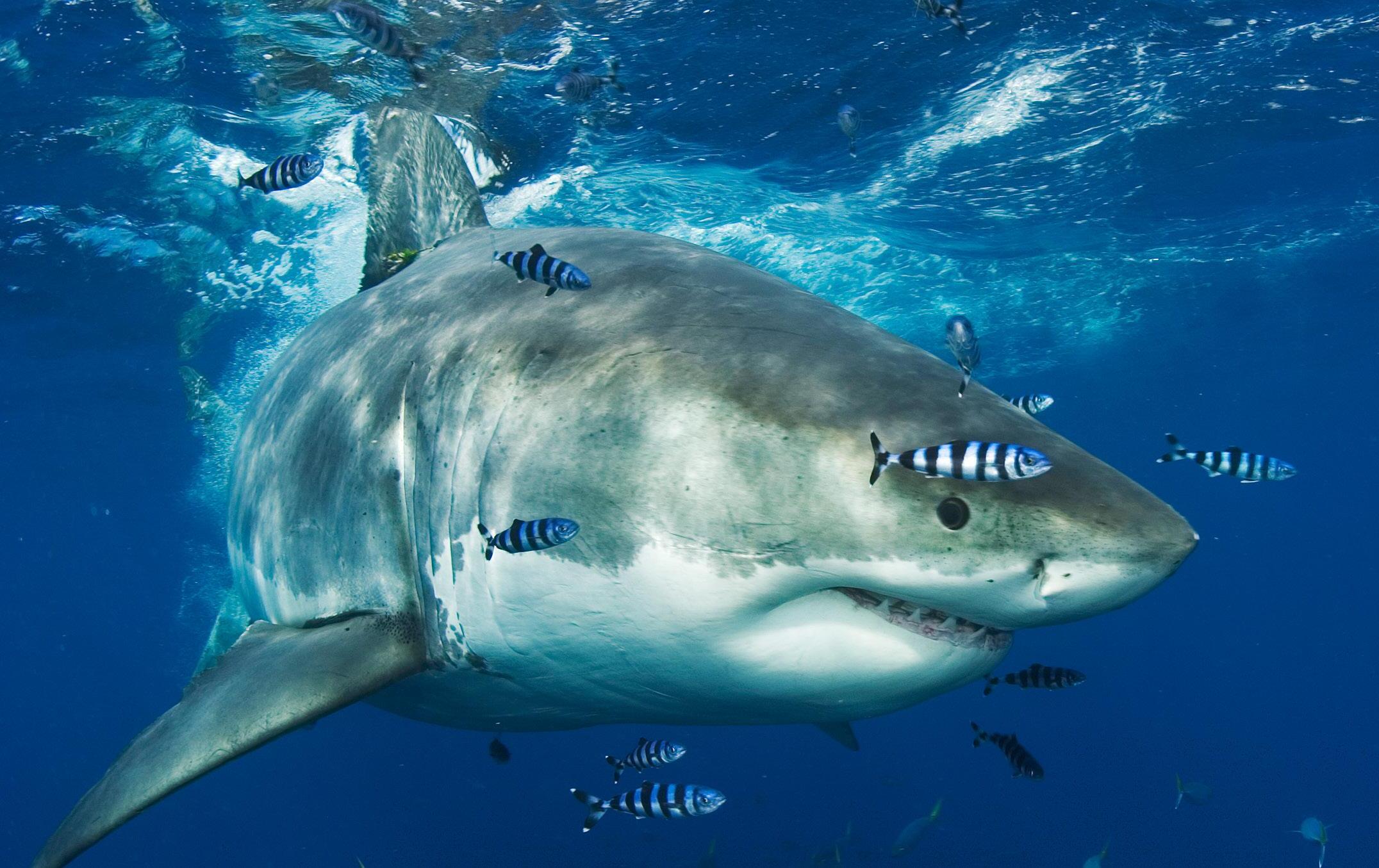
With shark specimens spanning hundreds of years, museums around the world are well placed to help conserve sharks.
One way they can do this is by providing a baseline for what sharks were like before they began to be impacted by humans. By studying how sharks collected in previous centuries differ from those caught more recently, researchers can understand how they’re changing.
Tissue and blood samples, for example, can reveal how levels of heavy metal pollution in a shark’s body have changed. Preserved DNA, meanwhile, can help scientists infer how shark numbers have changed over time based on their genetics, helping to target conservation action towards the most at-risk groups. ‘It’s important we keep adding to museum collections to continue tracking how shark populations are changing,’ Diego adds. ‘It’s especially important for neglected species, where these changes would otherwise be missed.’
Below The Museum is home to a huge set of jaws from a white shark caught off Port Fairy in Australia during the 1830s. The shark was about five metres long.
a human. In most cases, sharks then release the unfortunate person, retreat and don’t return.
Great white attacks are extremely rare
After the initial attack on Chrissie, Jaws’ shark subsequently eats four more people. While these attacks are spread over several days, a great white doesn’t normally feed this often. ‘After a large meal, great whites don’t need to eat again for some time,’ Diego says. ‘They tend to feed every few days, rather than continuously.’


It’s estimated that a 30-kilogram meal of blubber is enough to feed a great white for between a week and a half to two weeks, depending on how active it is. But they don’t usually go this long, and feed on seals every few days to keep their strength up. Humans are much less nutritious than seals, so a shark would need to eat more people to meet its energy requirements. The truth is, these animals just aren’t that interested in eating us. In 2024, only 47 people were injured in unprovoked attacks by all species of shark, and just four died.
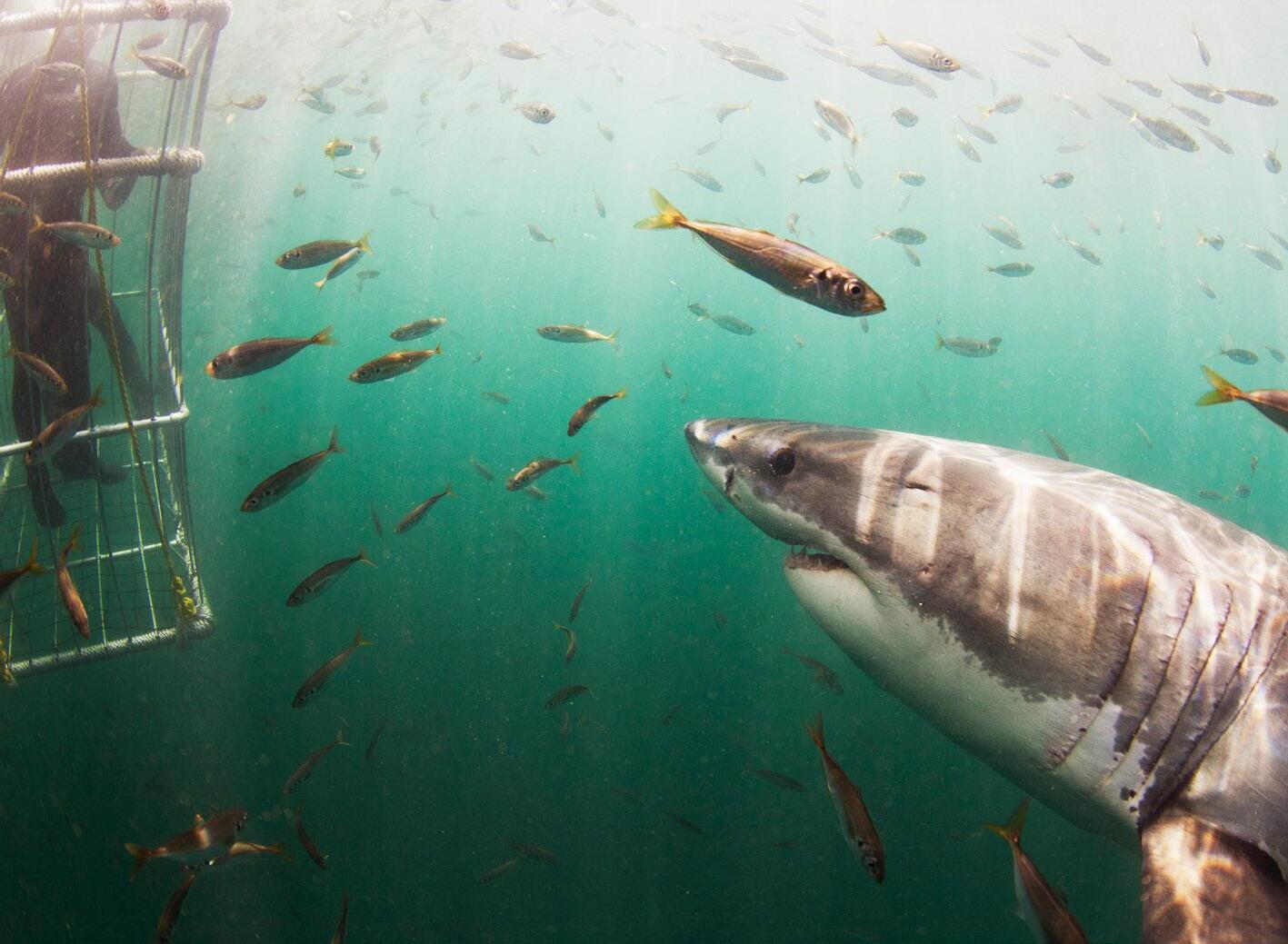
You are more likely to die from a toaster-related accident than an encounter with a shark.
Meanwhile, humans kill thousands of sharks every single day. An estimated 80 million sharks are killed by fisheries alone every year, either for their meat or as accidental bycatch when fishing for other species. As a result, shark populations have declined by more than 70% since the release of Jaws in the 1970s. This has unbalanced ecosystems as populations of shark prey species have grown, harming marine biodiversity around the world.
While bans on shark fishing have helped the animals to recover in some areas, the slow growth rates and long reproduction time of these animals means that it will take decades, if not more, for populations to recover.
After the trio of Chief Brody, oceanographer Matt Hooper and seadog Captain Quint lure the shark to their boat, named the Orca, Hooper estimates that it must be at least 20 feet (six metres) long. Quint disagrees, saying it’s 25 feet, which is about 7.6 metres. In reality, Hooper is probably right.
Finding Nemo
While fish are food for sharks, not friends, Finding Nemo inspired a passion for the ocean among generations of children.
The Meg
This is an entertaining slice of action silliness, if you ignore that the Megalodon died out over 3.6 million years ago.
Shark Tale
Though it might not have dated as well as Finding Nemo, this animated adventure highlights the social side of sharks.
A couple must fight for survival after being stranded in the ocean in this tense horror.
The moral of this action flick?
Don’t carry out unethical genetic experiments on sharks.
Below Despite the blood-soaked drama of shark horror films, in 2024, only 47 people were injured in unprovoked shark attacks, the lowest number in nearly three decades. This highlights how rare and misunderstood these encounters truly are.
‘Generally, most great white males are 3.5 to four metres long, while females are longer and often measure between 4.6 and 4.9 metres long,’ Diego says. ‘However, the largest great white sharks are estimated to be as long as six metres or more.’
While this means Hooper’s estimate is within the range of real sharks, there’s a catch – all the largest great white sharks are female. However, real-life footage used in Jaws clearly shows that it has sex organs known as claspers, which are only found in males. As a result, Jaws’ shark is much longer than any known male great white.
In the same scene, Quint also estimates that the shark weighs three tonnes, but this is also another exaggeration of a great white shark’s true size. The heaviest great whites are believed to weigh around two tonnes, but males are again much smaller – probably around 800 kilogrammes at their heaviest.

Later in the film, Quint manages to harpoon the shark and attaches the line to the back of the Orca
As the shark begins to pull the boat backwards and water floods into the engine, Hooper shouts, ‘It’s impossible!’ And he’s right about that.
‘While great white sharks are capable of swimming at speeds of up to 40 kilometres an hour, this is only possible in short bursts,’ Diego says. ‘Like a cheetah, they spend most of their lives moving at a

much slower pace, and only shift up a gear to their top speed for short bursts during a hunt.’
So, even if a great white was somehow able to pull such a large fishing boat, it wouldn’t be able to do it for as long as it does in Jaws.
Having dragged the Orca around, the shark subsequently starts to attack the boat itself. After its sides are breached, the Orca starts sinking and comes to rest on its side in shallow water. Once again, however, this is an example of Jaws’ dramatic license. To begin with, reported shark attacks on boats are extremely low, with just three recorded in 2024 worldwide. It’s likely that these are also a case of sharks that have mistaken the vessels for prey.
Even if a great white did want to sink a boat the size of the Orca, it’s highly unlikely that it would be able to do so. While surfboards and kayaks are vulnerable to a great white’s bite, larger vessels are simply too sturdy and reinforced for a shark to make any significant damage. In fact, large sharks are much more likely to be seriously hurt or killed by ships colliding with them.
Above Many species of shark have brains as complex as those of mammals, enabling them to process a wide range of senses – including vision, smell, electroreception and even social learning.
READ THIS
Learn more: nhm.ac.uk/discover/ great-white-sharkman-eater-ormarine-marvel
The idea that sharks can detect a single drop of blood from miles away is mostly myth.
Great whites don’t make noise During one of Jaws’ most terrifying moments, the shark crashes through the side of the sinking Orca, lunging toward Chief Brody. As it bursts into the cabin, a deep, unnatural roar fills the room. In later sequels, especially Jaws: The Revenge, the shark acquires a full-blown vocal repertoire, including growling and repeated roaring underwater.
But sharks don’t roar or growl. In fact, the vast majority of sharks don’t seem to make any sounds at all. While many fish can make a drumming sound using their swim bladder, sharks don’t have one of these organs, let alone any vocal cords.
The only sharks that are currently known to actively produce noises are rigs, a species of houndshark that lives off the coast of New Zealand. When handled underwater, they snap their teeth together to make a clicking sound, which may be a response to distress. While research continues to see if other sharks make sound, the great white is not currently among them.
Even 50 years after its release, Jaws still sets the tone for public opinion about sharks. Rather than being feared, these animals are an important part of marine life and deserve our respect. The time has come to reset our relationship with sharks, and give these essential predators the respect they deserve. Without them, the health of our oceans will be in far greater peril than Amity Island ever was. ●
‘Life
From Earth’s extremities to distant exoplanets, astrobiologist Nathalie Cabrol is searching for life. As Director of the Carl Sagan Center at the SETI Institute, she explores how life begins, how intelligence evolves, and how curiosity might connect us across the cosmos.
What is SETI, and what does the SETI Institute do?
At the SETI (Search for Extraterrestrial Intelligence) Institute, we ask one of the most profound questions imaginable: Are we alone in the universe? But that question is not singular – it’s a constellation of inquiries. To even begin answering it, we must understand how life begins, how intelligence emerges, and how we might detect its presence beyond Earth.
SETI’s work spans all scales of that exploration. We investigate the origins of life, its evolution, and the conditions that allow it to flourish.
We don’t broadcast messages. Our search is passive – using radio telescopes to listen for the faintest whispers and instruments like LaserSETI to scan the skies for signs of technologically advanced civilizations. LaserSETI, for example, monitors the night sky for brief laser pulses, which could be a form of communication used by distant intelligences. We’ve not heard anything yet, and we may not recognise it even if we do.
Our scientists also search the atmospheres of distant exoplanets for biosignatures – chemical clues, such as gases like methane or oxygen –that may suggest biological processes. But interpreting these signs requires understanding how planets evolve, how life interacts with its environment, and how those interactions leave detectable fingerprints.
And closer to home?
We don’t stop at space. We turn inward, to Earth’s most extreme environments – places where life is pushed to its limits and where the planet itself becomes a testbed for astrobiology.
I’ve led more than a dozen expeditions to highaltitude lakes in the Andes, including Licancabur, Poquentica and Aguas Calientes, climbing to nearly 6,000 metres to dive into crater lakes that mirror the conditions of early Mars. These sites are cold, dry, oxygen-poor and bombarded by intense ultraviolet radiation – yet life persists.
That’s what makes them natural laboratories. We study how microbial communities adapt, how ecosystems respond to rapid climate change, and what biosignatures they leave behind. These lakes help us refine our exploration strategies, test instruments for future missions, and understand the thresholds of habitability – not just for Mars, but for Earth itself.
What can Earth’s extremes teach us about life’s resilience – and our own planet?
These expeditions reveal how life responds to environmental stress – how it adapts, evolves, and leaves behind clues that we can learn to detect on other worlds. By decoding these survival strategies, we refine the tools, technologies and exploration methods needed to search for life beyond Earth. But astrobiology doesn’t just look outward. It also holds up a mirror. As we ask, What is life? Where are its limits? we begin to reflect on our own planet – on the delicate balance between biology and environment, and the thresholds that define habitability here at home.
What makes K2-18b such an intriguing target in the search for extraterrestrial life?
Life doesn’t exist in isolation. It co-evolves with its planet – shaped by its chemistry, its climate, its history. That’s why we can’t point to a single molecule and claim a biosignature. Take exoplanet K2-18b. It’s a fascinating world: larger than Earth, →
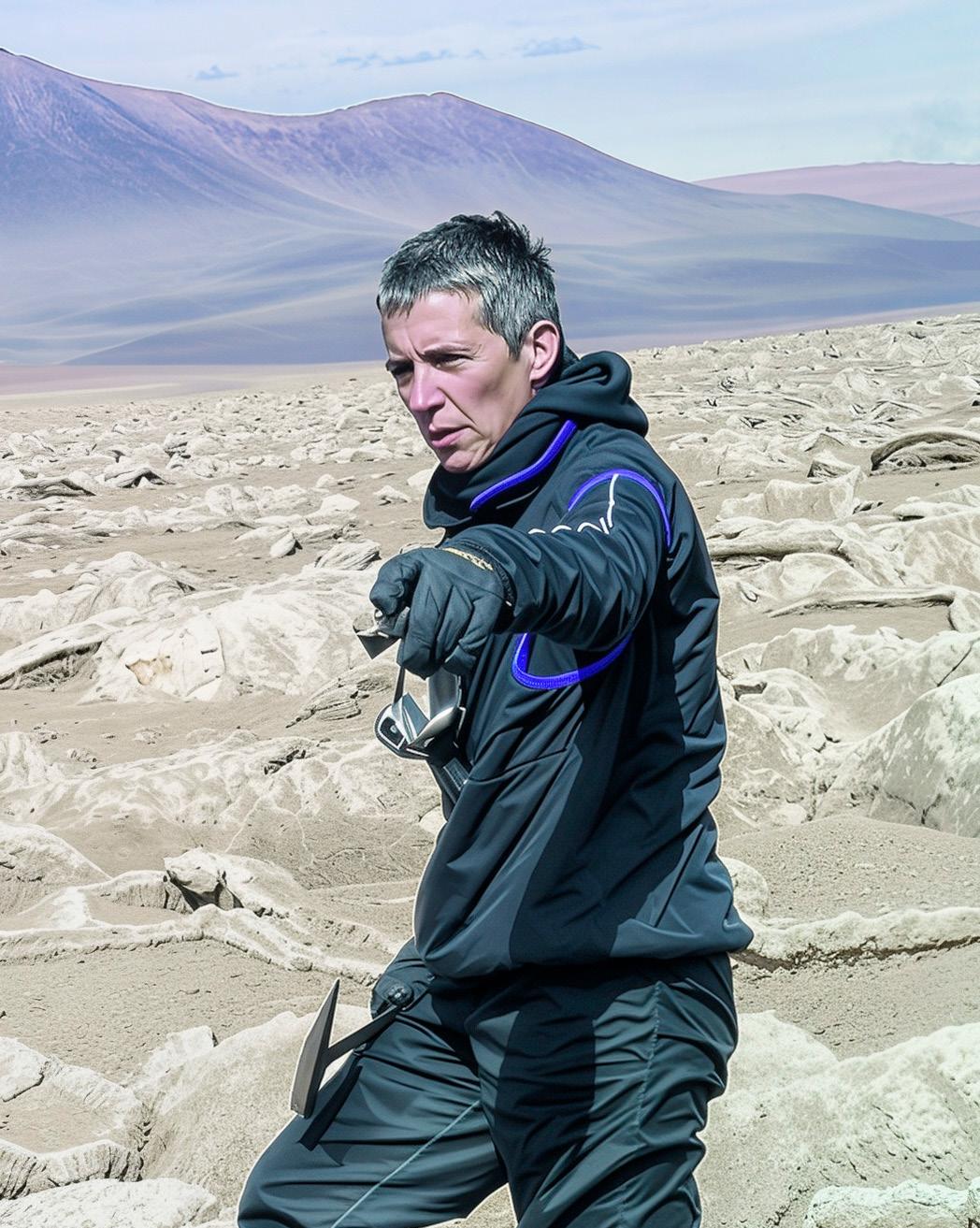
At Laguna Blanca, Argentina, Nathalie dove into one of Earth’s highest lakes to study life at its limits and unlock clues to habitability on Mars and beyond.

SETI investigates extreme environments on Earth to understand how life might survive in harsh conditions elsewhere in the universe.
orbiting a red dwarf star about 124 light-years away, and sitting in the habitable zone where liquid water might exist.
Recent observations from the James Webb Space Telescope revealed hints of dimethyl sulfide – a molecule that, on Earth, is produced almost exclusively by living organisms like marine phytoplankton. That’s exciting. But it’s not enough. We don’t yet know if K2-18b has oceans, a surface, or the environmental conditions that could support life. Without that context, a molecule is just a molecule. The next step is always deeper understanding – more data, better models, and a clearer picture of the planet as a whole. Only then can we begin to ask the right questions about life.
Could life exist without water or carbon?
Astrobiology doesn’t assume that water- or carbonbased life is the only possibility. But it’s reasonable to think it might be common. The elements that make up life as we know it –carbon, hydrogen, oxygen, nitrogen, sulphur and phosphorus –are among the most abundant in the universe. That’s not a coincidence. Water is also widespread. And thanks to exoplanet research, we now know that temperate, rocky worlds with liquid water are plentiful. So while we may not be the only model, it’s not unreasonable to expect other life forms to use similar chemistry.
Still, even with the same ingredients, life could look very different. We use only a fraction of the amino acids available in nature. In the lab, we can create many more. So even familiar building blocks can lead to unfamiliar outcomes.
What is the Fermi Paradox?
The Fermi Paradox asks why, if intelligent extraterrestrial life is likely to exist in the vast universe, we haven’t found clear evidence of it yet. But I’m not a fan of that framing. It assumes that aliens would think and act like us – that they’d have the same goals and ways of interacting.
Yet our minds are shaped by four billion years of co-evolution with Earth. Life on another planet would evolve differently – and so would its intelligence. That doesn’t mean there’s no common ground. Any civilization capable of developing technology must possess curiosity and a drive to explore – qualities we might share.
But do they want to meet us? That’s our curiosity speaking – not necessarily theirs. The real question isn’t where are they? It’s what are they? Because what they are will shape how they think, how they act, and whether they ever choose to make themselves known.
How do we tell if a signal is artificial or natural?
My life in a nutshell
I originally wanted to be an astronomer, but I wasn’t great at maths or physics, so I majored in Earth sciences. A chance encounter before my master’s led me into planetary geology.
My hobbies include trekking, mountaineering and diving – which is convenient, since I do all three during fieldwork in Earth’s most extreme environments.
I hold the women’s world record for altitude diving at Licancabur Volcano’s crater lake, in the Andes.
As Director of the Carl Sagan Center, I’ve expanded its focus to include environmental science and ensure that space technologies benefit Earth as well.
Science begins with questions. And sometimes, those questions lead us to unexpected places. We might be searching for alien signals and instead detect gravitational waves – unexpected cosmic phenomena that expand our understanding in entirely different ways.
That’s not a failure, it’s a discovery. It teaches us about the universe’s structure and helps us understand the conditions for life.
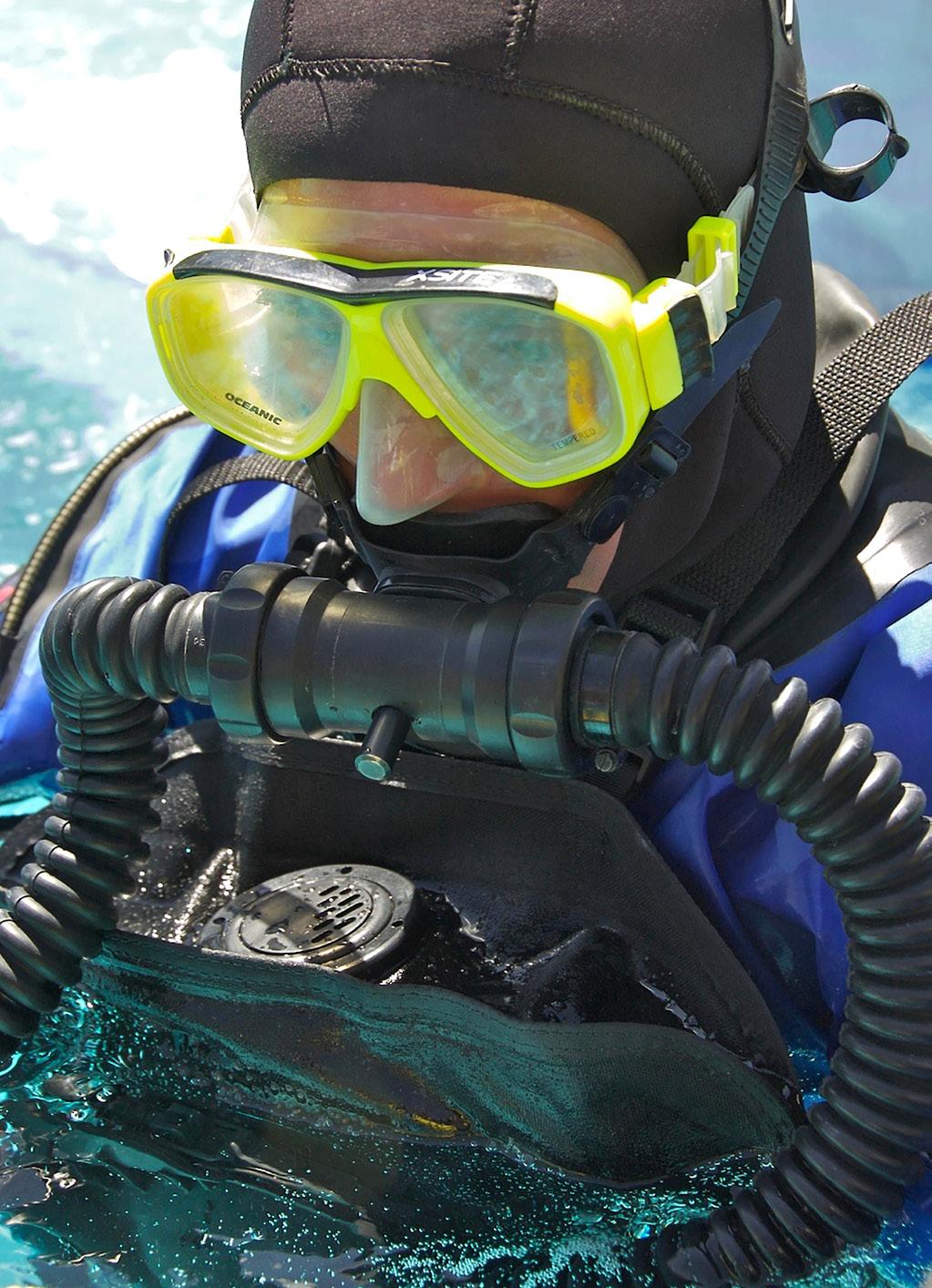
For the dive at Laguna Blanca, Nathalie and other SETI researchers set up a high-altitude field camp – surrounded by volcanic peaks and alkaline waters – to study microbial life in Mars-like conditions and test instruments designed to detect biosignatures on other worlds.

When we detect something unusual, we don’t jump to conclusions. We build hypotheses, design experiments, and test them. That’s how breakthroughs happen.
I believe we’ll stumble into life – or life will stumble into us – when we least expect it. Discovery comes from observation. And observation comes from curiosity.
If we received a message from space, how would we translate it?
We’d start with universal languages: physics, mathematics and symbolic logic. These are rooted in shared processes, not culture. Researchers at METI (Messaging Extraterrestrial Intelligence) International are exploring how to craft messages that could be understood by other civilisations.
At the SETI Institute, we’re also studying communication among intelligent species on Earth – including dolphins, whales, bees and ants – and analysing their language structures. What we’ve found is that species we consider intelligent tend to have complex grammar. And, intriguingly, their syntax – the rules that govern how signals are arranged – often resembles ours. That raises a fascinating question: is this
similarity a universal feature of intelligence – or simply the result of shared evolutionary history, a kind of linguistic echo from our common origins on this planet?
Either way, this research on Earth deepens our understanding of communication. And it reminds us that we share this planet with many forms of life, each with its own way of expressing awareness.
What excites you most in astrobiology today?
For decades, we’ve tried to define life – to pin it down, categorise it and search for it in familiar forms. That’s important, but it’s also limiting. Exoplanets have changed everything. They’ve opened a new gallery of worlds for us, expanding our sense of what’s possible – new chemistries, new environments, new ways of being alive.
I believe the next revolution in the field of astrobiology will be conceptual. We’ll move beyond definitions and start thinking of life as a process, not a thing. Life doesn’t just appear – it emerges from a world. The next five to 10 years will be transformative.
And yes, discovering life elsewhere would be revolutionary. But even without that, the journey itself is extraordinary. ●

Buy the book
Nathalie Cabrol’s book The Secret Life of the Universe: An Astrobiologist’s Search for the Origins and Frontiers of Life, released in August 2024, is available from all good bookshops.
To some Richard Owen was a genius, to others a devil. He created the Natural History Museum, gave us the name dinosaur – and Charles Darwin was his sworn enemy. Karolyn Shindler explores this complex and contradictory natural scientist.
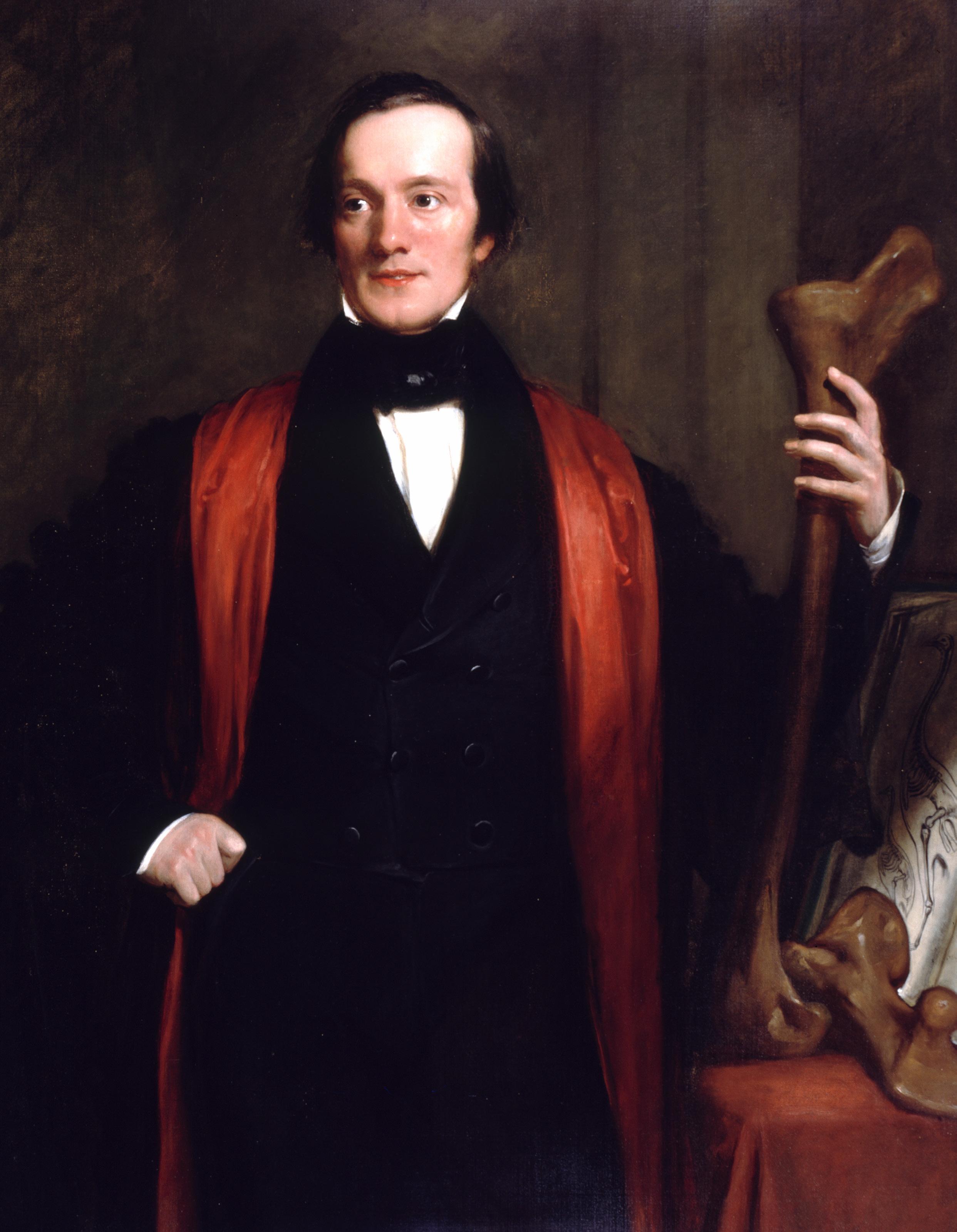
To Charles Darwin, Professor Richard Owen (1804–1892) was ‘that beggar Owen’, ‘that devil’, and ‘that canting humbug’.
To The Times he was the most ‘distinguished man of science in the country’. The future Prime Minister William Gladstone praised him as ‘the greatest living naturalist’. The fossil-hunter Dr Gideon Mantell said he ‘was the picture of malevolence’, while for the diarist Caroline Fox, Owen’s face was ‘full of energetic thought and quiet strength’.


So, the contradictory list of his perceived villainy and virtue goes on. Even before his death in 1892, his work had been marginalised and overshadowed by his supposed anti-Darwinism, his reputation in tatters. What should truly matter – the outstanding quality of his science and his lasting legacy – was successfully obscured. The question is, why?
Scientific luminary
Richard Owen’s achievements are extraordinary. Before Darwin, he dominated natural science. Elected a Fellow of the Royal Society at the age of 30, he was an outstanding comparative anatomist, with an unrivalled range and depth of knowledge of living and extinct animals. He gave us the name
Above Owen’s personality, rivalries and supposed opposition to Darwin’s theory of evolution have made him a polarising figure in scientific history.
Below Cartoon from Palaeontographical Society Anniversary Dinner menu, 17 April 1874.
dinosaur, described countless new species and published well over 600 books and papers. In 1839 he was sent a 15cm fragment of bone from New Zealand. From it he described an extinct large, flightless bird – bigger than an ostrich – yet there was no evidence that such a bird had ever existed. Four years later he was sent complete bones that confirmed his identification. The giant moa became the iconic symbol of Owen’s brilliance – his ability to re-create from fossil fragments the likeness of monstrous extinct beasts that had once inhabited Earth.
He was an adviser to governments and reported on environmental health matters. He was a famous and popular lecturer and writer, as well as an academic one, and was on the organising committee for the Great Exhibition of 1851. In 1854 he directed the reconstructions of the marvellous Crystal Palace dinosaurs, built by Benjamin Waterhouse Hawkins, which you can still see today. He was awarded more than 100 medals, fellowships and knighthoods, including the Royal and Copley medals of the Royal Society and the Prix Cuvier of the French Academy. And we have him to thank for the creation of the Natural History Museum. His scientific drawings are skilled, his sketches in his notebooks delicate and attractive. He was
Our heritage → Owen dines at the Palaeontographical Society with some of the prehistoric creatures he described.

heritage
a talented musician with a fine singing voice and, as evidenced by his family papers, was a loving husband, father, son and brother. Among his friends were Charles Dickens, the artist JMW Turner, the poet laureate Lord Tennyson and prime ministers Sir Robert Peel and William Gladstone. Charles Darwin was also a friend –until that friendship turned to acid.
Foe and feud
Owen’s illustration of the pearly nautilus from his 1832 memoir on it, which led to his election as a Fellow of the Royal Society.
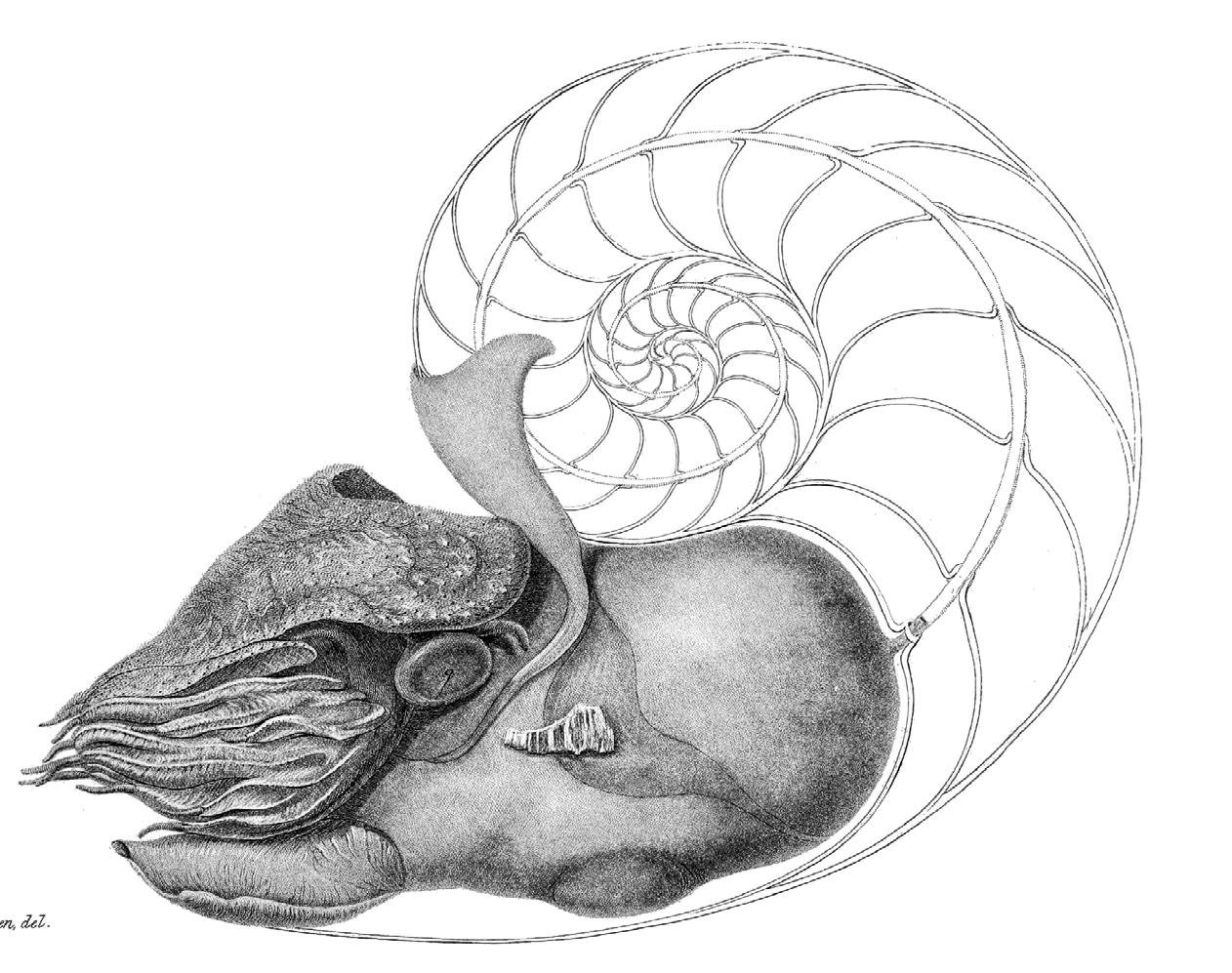

Owen was given a 15cm bone in 1839 (in his right hand), and from this he deduced that a large flightless bird had lived in New Zealand. Meet the giant moa.
Owen’s great mistake was to make an enemy of Darwin, who called him ‘that devil’
briefly, at Edinburgh University. Darwin had private means, and the freedom to think the unthinkable. Owen had to work for a living and could not afford to alienate the established beliefs of his employers and patrons. Those he had to balance with his own developing ideas.
But his was not an auspicious start. His schoolmaster said he was lazy and impudent and would come to a bad end. Apprenticed to a local surgeon apothecary at 16, he found something that did engage him: he became fascinated by dissection and anatomy, and developed an astonishing focus and ambition. He so impressed his lecturers at both Edinburgh University and then at St Bartholomew’s Hospital, in London, that in 1827 he was recommended for the post that would change his life – assistant conservator at the Royal College of Surgeons.
On love and legacy
The college housed the collection of the surgeon and collector John Hunter – a cornucopia of human and zoological specimens that weren’t catalogued and in many cases bore no labels. The Conservator of the Hunterian Museum, William Clift, needed someone with Owen’s skills.
It was here Owen made his reputation and where he remained until 1856. He became, literally, part of the family. William Clift’s daughter Caroline was a self-educated woman of intelligence and humour who had taught herself languages, art, music and comparative anatomy. Small and attractive, the diarist Caroline Fox described her →
1804–24
Born in Lancaster, 20 July, the second of six children. At 16 Owen is apprenticed to surgeon apothecaries. Part of the work is postmortem dissections of convicts who died in Lancaster gaol. In anatomy Owen finds his passion in life.
1827–56
Appointed assistant conservator at the Hunterian Museum at the Royal College of Surgeons. He is 22. Here he makes his name as an outstanding natural scientist and influential lecturer.
1835–73
Marries Caroline Amelia Clift, the daughter of William Clift, Conservator at the Hunterian. She’s a self-taught linguist who has studied comparative anatomy. It’s a true love match. Their son William is born in 1837. (1)
1842
Owen introduces the order Dinosauria. Appointed Conservator at Hunterian. First meets the historian Thomas Carlyle, who describes him as a ‘tall man with glittering eyes’.
1845
Begins campaign for a national museum of comparative anatomy. While he has support from senior politicians and some scientists, he’s vehemently opposed by others, including the biologist Thomas Henry Huxley.
1852
Queen Victoria grants him a grace-and-favour home, Sheen Lodge in Richmond Park. His son’s family live there long after Owen’s death. (2)




1856–1881
Relations with the Royal College of Surgeons had become acrimonious by 1856, and he resigns. He’s appointed superintendent of the natural history departments of the British Museum – a role created for him.
1873
His beloved wife Caroline dies. She’s buried at Ham churchyard. After years of campaigning and argument, work begins on building the Natural History Museum in South Kensington – Owen’s great legacy.
1881–4
The Natural History Museum opens to the public on Easter Monday. At the end of 1883, he retires. He is created a Knight Commander of the Bath. (3)
1892
On 18 December Owen dies at Sheen Lodge aged 88, after years of declining health. He outlived most of his friends and supporters. (4)

Charles Dickens 1812–1870
Owen and Dickens first met in 1843. Owen was a great fan of Dickens’ novels, Dickens persuaded Owen to write for his magazine Household Words. Dickens famously references Owen in a number of his works including Our Mutual Friend and Bleak House. They also shared interests in social matters, particularly public health. (1)

1

2
Charles Darwin 1809–1882
Their relationship began harmoniously in 1836 when they studied Darwin’s Beagle fossil mammals. It fractured over their differing views on the origin of species, but it was also a power-play, with Darwin and his supporters fiercely opposing Owen’s plans for a national museum of natural history. (2)
Thomas Henry Huxley 1825–1895
William Ewart Gladstone 1809–1898
Gladstone, Liberal MP, Chancellor of the Exchequer and British Museum Trustee (later he became Prime Minister), was the most influential supporter of Owen’s plans for a new museum. He recommended Owen for a knighthood on his retirement, and secured him a pension of £100 a year.
Joseph Mallard William Turner 1775–1851
They met in 1845. Turner invited Owen to his home in London to see his paintings. In the studio Turner was working on several easels at once. His paints were on a circular table, which he swung round. Owen advised him on zoology subjects, particularly whaling.
In 1851, Owen helped Huxley obtain funding for his paper on his voyage in the Rattlesnake and with his election as Fellow of the Royal Society. Huxley wrote ‘I am greatly indebted to him’, and then began attacking Owen’s science, his Museum plans – anything that would promote his own career.
Gideon Mantell 1790–1852
Mantell was a Sussex doctor and palaeontologist who, with his wife, discovered the first Iguanodon fossil in 1822. He often clashed with Owen over key fossils, including Cretaceous specimens from Sussex, interpretations of belemnites, and the origin of moa bones. For Mantell, Owen was that ‘poor envious man’ who uttered ‘atrocious falsehoods’.
as ‘a very perfect little Fact in the great history of the world’. Owen fell deeply in love with her and, as their letters show, they were swiftly engaged, though they were forbidden to marry for another eight years.
Owen’s life spans the nineteenth century – a time of incredible developments in transport, industry and technology, paralleled by radical new philosophies and a revolution in both theory and understanding of the age and nature of the Earth. There were many in the church who still believed the Bible was the literal truth, but also many who realised that could not possibly be so, as every new palaeontological and geological discovery revealed that the Earth was vastly older.
Today it’s almost impossible to comprehend that revolution of thought, the discovery that unimaginably huge animals had once roamed the Earth, and, equally unimaginably, had vanished, to be succeeded by a vast diversity of life. And that gave rise to what Darwin called the ‘mystery of mysteries’ and Owen the ‘question of questions’ – the origin (and extinction) of species. It would be simple if the enmity between them could be viewed as a battle between atheists and theists, with Darwin the moderniser



Richard Owen‘Old Bones’ - was featured in Vanity Fair in 1873 in their ‘Men of the Day’ series, the same year work began on his new Natural History Museum.

against Owen the biblical creationist, doing all he could to block progress. That was the narrative that prevailed for about 80 years after Owen’s death. But it’s not simple. Owen’s argument with Darwin was not about evolution itself, but the forces that brought it about.
One reason for Darwin’s hatred of Owen was that he felt betrayed and misled. He’d sent Owen a pre-publication copy of On the Origin of Species and, following their conversations and correspondence, came to believe – as Darwin confided to his friend, the geologist Sir Charles Lyell in late 1859 – that ‘at bottom he goes immense way with us’. Furthermore, Darwin added, ‘He said to effect that my explanation was best ever published of the manner of formation of species.’ Yet at that same meeting, Darwin told Lyell, Owen had also said, ‘If I must criticise, I should say “we do not want to know what Darwin believes & is convinced of, but what he can prove”.’
Yet in the spring of 1860, Owen published a scathing anonymous review. He cited 10 other works – three of which he authored himself – not only to bolster his critique but also to outline his own evolutionary stance. The tone was patronising, sarcastic and dismissive. Darwin, Owen wrote, ‘expresses belief where one looks for a demonstration’, echoing remarks he’d already made directly to Darwin. It has also been suggested Owen was outraged that Darwin had listed him as an anti-evolutionist in On the Origin of Species, when he must have known he was not.
Darwin described the review as ‘spiteful, extremely malignant, clever and… damaging’, but it damaged Owen more than Darwin. Darwin’s allies, particularly biologist Thomas Henry Huxley, increased their attacks on Owen. They even sought to derail Owen’s campaign, dating back to the 1840s, to establish a separate museum of natural history.
See Richard Owen: A Natural Legacy in the Museum’s Images of Nature gallery (Blue Zone). The display explores his extensive artwork collection, as well as his own sketches and illustrations – much of which has never been on public display.
Thomas Brock’s bronze statue of Sir Richard Owen can be found on the Museum’s first floor balcony.
Left Lithograph of extinct animals by Benjamin Waterhouse Hawkins, the sculptor for these and the other magnificent monsters in Crystal Palace Park. Richard Owen was his scientific adviser. The print can be seen in Sir Richard Owen: A Natural Legacy in the Images of Nature gallery.
As more recent protagonists have written, Darwin won the argument over evolution and his supporters wrote the history. Owen’s scientific legacy was overshadowed by his flaws, which critics amplified with lasting effect. He could be harsh, dismissive and unfair to fellow scientists and, at times, failed to credit others’ work. Though capable of writing with great lucidity, Owen was equally adept at cloaking meaning in dense, convoluted and sometimes impenetrable prose which could – and did – lead to misunderstandings.
Admired by many
Yet for every critic who loathed or feared Richard Owen, there were many who liked and admired him – as reflected in the 27 volumes of Owen correspondence held by the Museum. His meticulous reviews and recommendations helped shape scientific careers, yet it was his demonisation that dominated the narrative for decades, eclipsing his many contributions.
If bibliographer and geologist Charles Davies Sherborn hadn’t been asked by Owen’s family in the 1890s to organise his papers, Owen’s vast and invaluable archive might also have been lost. His marginalisation was so complete that when, in the 1960s, his granddaughter Frances Hirtzel offered three volumes of his correspondence to this Museum, the offer was refused. She gave them to an American university instead.
Today, Owen’s immense contribution to natural history is slowly being acknowledged and his reputation rehabilitated. Defining him through his outstanding science rather than his perceived flaws would be a start. Perhaps the next step might be to move his statue from its obscurity above Hintze Hall to a more fitting and prominent location – ready for the 150th anniversary in 2031 of the Museum he so passionately fought to create. ●
While today dogs are mainly beloved pets, our Archives reveal a curious history of how Victorian canine companions came to be part of the Museum’s collection.
WORDS:
REBECCA KEDDIE, ASSISTANT ARCHIVIST
Visitors to the new Fixing Our Broken Planet gallery may be surprised to encounter two mounted taxidermy dogs in a display on carbon pawprints. Their time at the Museum began around a century ago, during a drive to collect and exhibit domestic animals.
In the early 1900s, Museum zoologist Richard Lydekker placed an advert in the Kennel Club appealing for donations of deceased dogs. This initiative aligned with an emerging vogue among middleand upper-class Victorians for pedigree dog breeding.
The Museum’s motivations are revealed in the guide to the 1908 exhibition, written by Assistant Keeper BowdlerSharpe, which argued that studying artificial selection through breeding could improve understanding of natural selection.
Ingledene Bonitablue, a rare blue-coloured pug, was preserved by the Museum.
Many dog owners loved the idea of their prize-winning pets and pedigree pooches being preserved and displayed at the Natural History Museum. Letters reveal that donors often took the initiative in offering their dogs to be taxidermied. Roy Falcy even sent off his two Syrian greyhounds before the Museum had agreed to accept them.
Some dogs were donated for their pedigree status or unique features, such as Ingledene Bonitablue, a blue pug
The Museum’s Archive holds material relating to its history, including architectural plans, expedition reports, research notes and correspondence, specimen records and staff photographs.


given by Grace Bellamy, who owned the only five pugs of that colour in the world. Others were notable because of their owners, such as the Tibetan mastiff that once belonged to George V. Or because of their own achievements – such as Mick the Miller, a champion racing greyhound and film star.
The dogs remained on display at South Kensington until the 1940s, when they were relocated to the Natural History Museum at Tring. Here, many of the dogs can still be seen today. ●
Visit us
Our Archives are open to the public by appointment, 10.00–16.00 on Tuesdays, Wednesdays and Thursdays. For more information, please email archives@nhm.ac.uk THE MUSEUM IN ACTION

Help us transform the Natural History Museum
For almost 150 years, the Museum has inspired over 200 million visitors with the wonders of the natural world. But we want to do more. We have embarked on a new fundraising campaign, to raise £150 million to complete our transformation of our original building and invest in our scientific research and public programmes. By joining our community of patrons, you will be part of the change and experience the Museum in unparalleled ways.
LEARN MORE
nhm.ac.uk/support/patronage GET IN TOUCH
patrons@nhm.ac.uk
Created by Amit Eshel, this image of a family of Pallas’s cats won Highly Commended in the Animal Portraits category of the Wildlife Photographer of the Year Competition.
